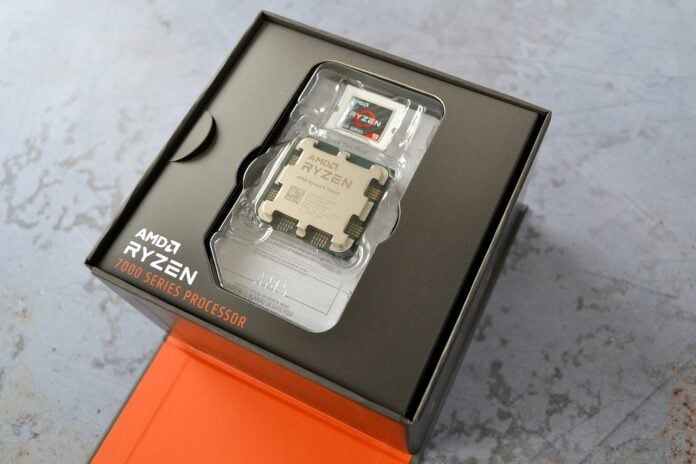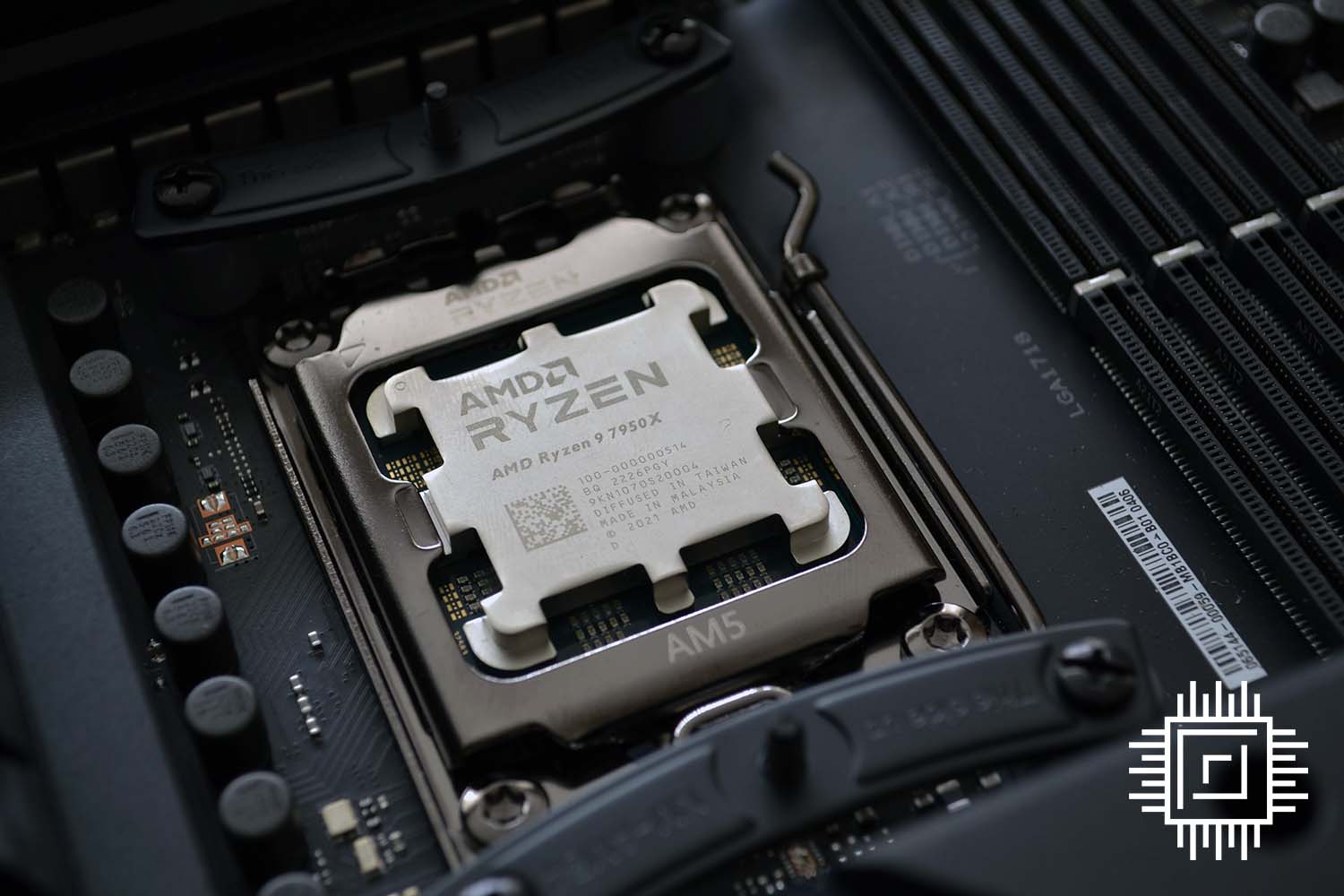AMD has successfully made the transition to Ryzen 7000 Series CPUs and AM5 motherboards this fall. Offering a tasty combination of vastly higher core frequencies, improved IPC, and a cutting-edge platform, perhaps the only disappointment is the lack of progress on core-and-thread counts. Mirroring what’s available on Ryzen 5000 Series has put AMD in a tight spot when compared to Intel’s insatiable appetite to boost everything for 13th Gen Core.
While rival Raptor Lake rightfully takes plaudits in the mid-range battle – Core i5-13600K is the best CPU for budget-balanced desktops of 2022 – AMD remains strong at the top end of the stack. Ryzen 9 7950X is a formidable multi-core powerhouse. But what about the 12C24T Ryzen 9 7900X, we hear you ask? Can it hold firm against pain instigated by the Raptor Lake onslaught? Before we answer this pressing question, first an in-depth recap on what makes Ryzen 7000 Series CPUs tick.
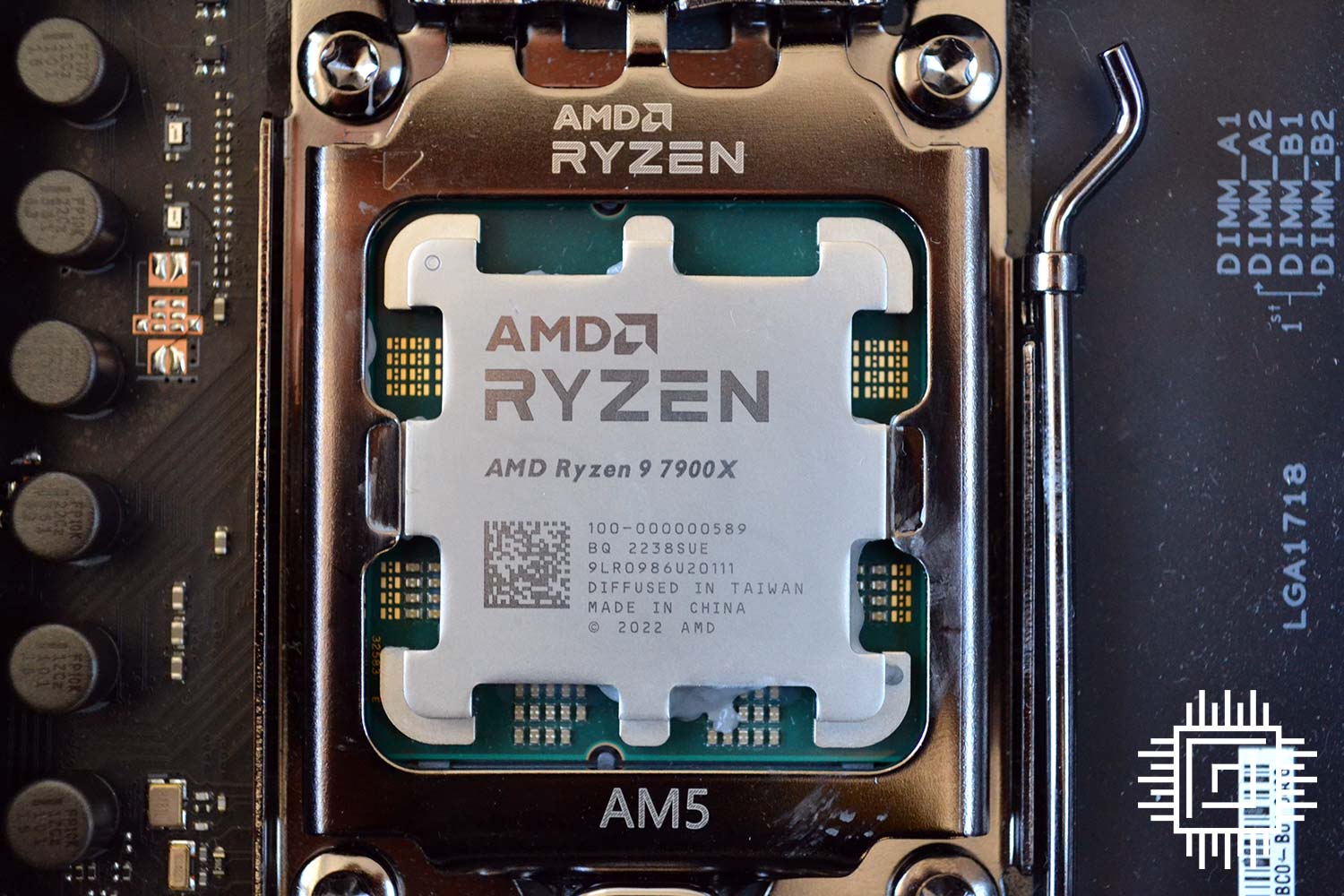

AMD Ryzen 9 7900X
£499 / $549
Pros
- Huge strides over last gen
- Futureproof platform
- Restrained power
- Good gaming chops
Cons
- Core i7 still cheaper
- DDR5 only
Club386 may earn an affiliate commission when you purchase products through links on our site.
How we test and review products.
Each evolution of a base architecture presents designers with an opportunity of doing things better. The beating heart of Ryzen 7000 Series is Zen 4, which is the brain that powers CPU cores. Like before, up to two core complexes – each carrying eight cores and 16 threads – hook up to a central input/out die (IOD). The devil is in the details when teasing out gen-on-gen improvements.
All About The Core
Outside of hard-nosed architecture refinements – steady your horses, technical readers – AMD doubles each core’s L2 cache from 512KB to 1MB, though closer-to-the-core L1 and more distant L3 remain at Ryzen 5000 series per-core levels of 64KB and 4MB, respectively.
But wait a second, doesn’t adding more cache balloon the transistor count and, potentially, die space? Yes, it does, but AMD’s magic trick is in adopting foundry partner TSMC’s 5nm high-performance process, down from 7nm used since 2019, and the net effect Zen 4 is able to shoehorn >50 per cent transistors yet take up less space. David Copperfield would be proud.
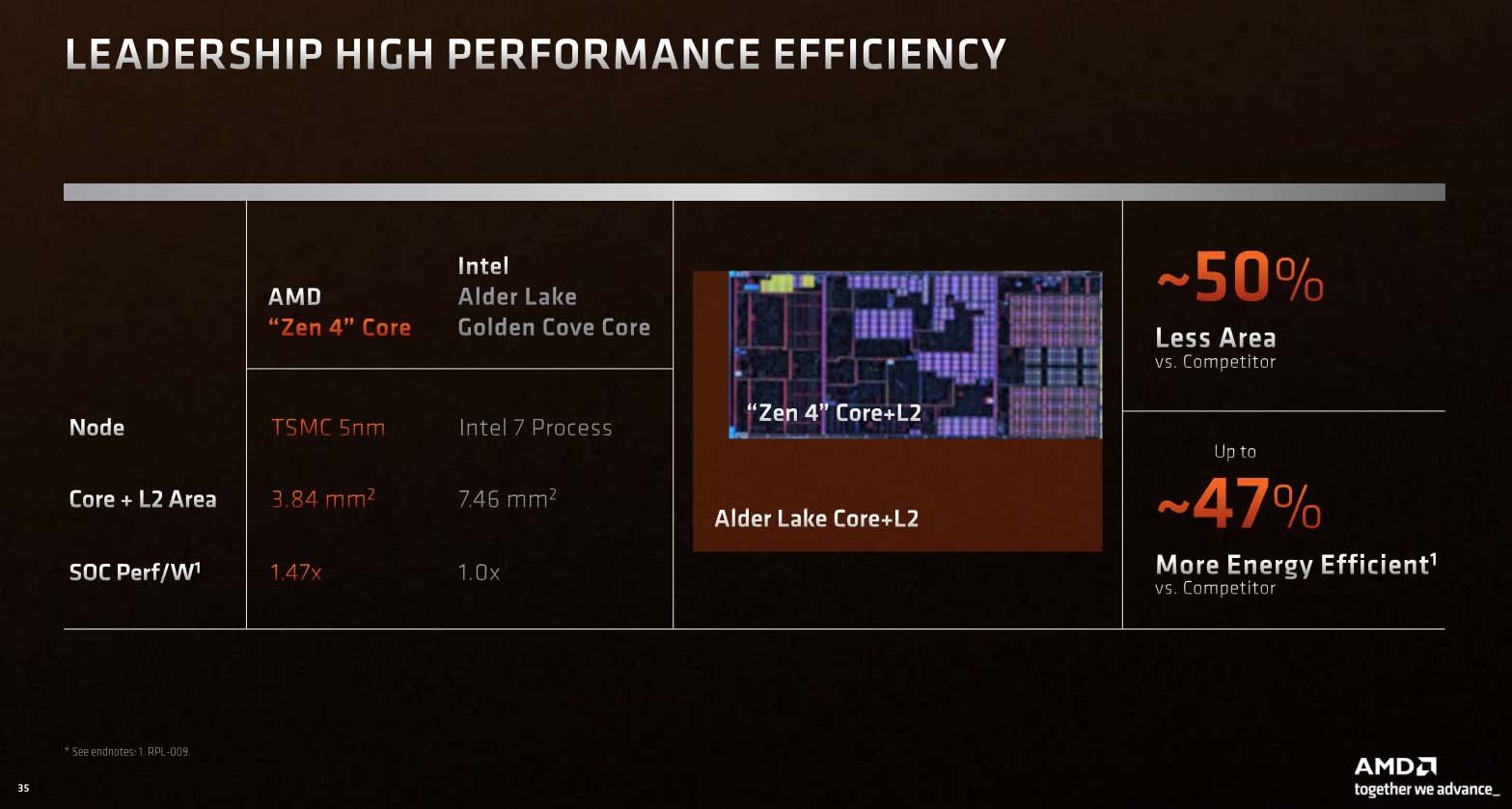
AMD takes an overt swipe at rival Intel by declaring each Zen 4 core and associated L2 is almost half the size of 12th Gen Golden Cove cores and their L2 cache. Hard to argue against that from a manufacturing viewpoint.
| Zen 4 | Zen 3 | |
|---|---|---|
| CPU fabrication process | 5nm | 7nm |
| CPU die size | 71mm² | 80.7mm² |
| CPU transistors | 6.50bn | 4.15bn |
| IOD fabrication process | 6nm | 12nm |
| IOD die size | 122mm² | 125mm² |
| IOD transistors | 3.40bn | 2.09bn |
New GPU-Laden IOD
AMD also invests a lot of extra silicon to the IOD die, which shrinks from 12nm to 6nm for the latest chips. Finding out where the extra 1.31bn transistors go is actually easy. As the IOD controls external interfaces to features such as memory and connectivity, there’s some extra die space apportioned there.
But that’s not the whole shebang. AMD grasps the die-size reduction opportunity with both hands and integrates graphics into the IOD. The question isn’t one of why, but one of why not, given the graphics heritage imbued in the company.
All Ryzen 7000 Series CPUs carry RDNA 2 graphics as standard. Don’t get too excited and think you can ditch that Radeon RX 6600 XT or GeForce RTX 3060. That’s not happening as the IGP is comprised of a two-CU, 128-shader cluster pulled over from mobile technology.
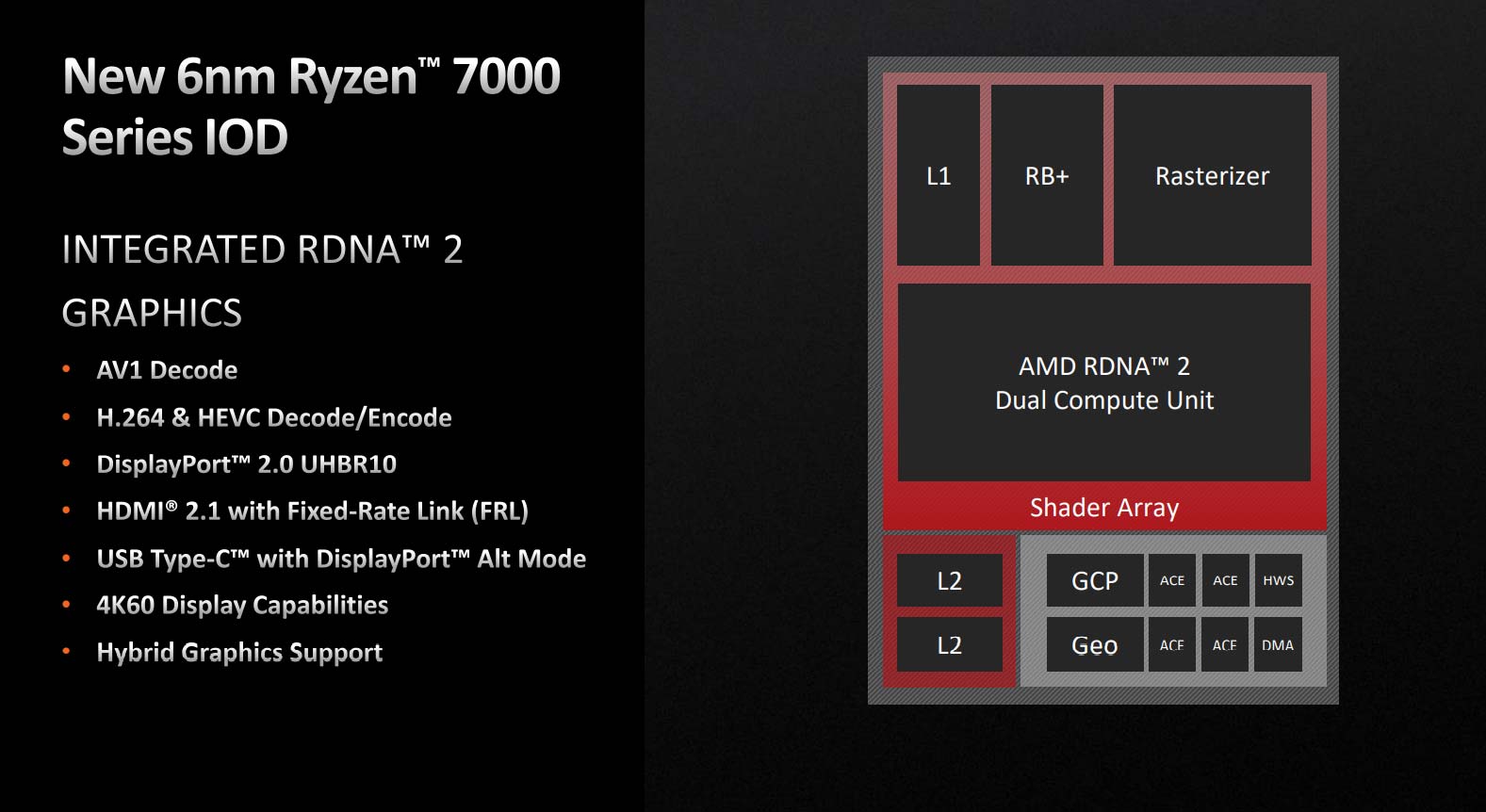
The main purpose of these graphics is to enable all Ryzen 7000 Series CPUs to fit into systems that don’t require heavy GPU capability. Truth be told, that’s millions upon millions of PCs, and AMD has historically required add-in discrete cards for most 5000 Series chips or resorted to a few G Series. Intel, on the other hand, has been mining this rich volume seam for years with low-power, flexible-output IGPs baked into each generation of Core. AMD wants a slice or two of that pie.
The two-CU GPU arrangement is eerily similar to the built-in graphics on just-announced Ryzen 7020 Series processors. Expect a pinch of gaming performance for light-load eSports titles played at, say, 720p with basic settings, yet display flexibility is arguably as important. The GPU features a strong roster of encode/decode abilities and display outputs – certainly enough not to need a discrete card in a small-form-factor PC. AMD has severed the necessary link between most Ryzen processors and discrete cards, and that’s a good thing.
What’s Going On, Zen 4
Resident CPU guru and known as ‘father of Zen’ in close-knit circles, Mike Clark headlined the recent Architecture Day by positing Zen 4 enjoys a geomean average 13 per cent instructions-per-cycle (IPC) uplift over in-market Zen 3, judged at the same frequency.
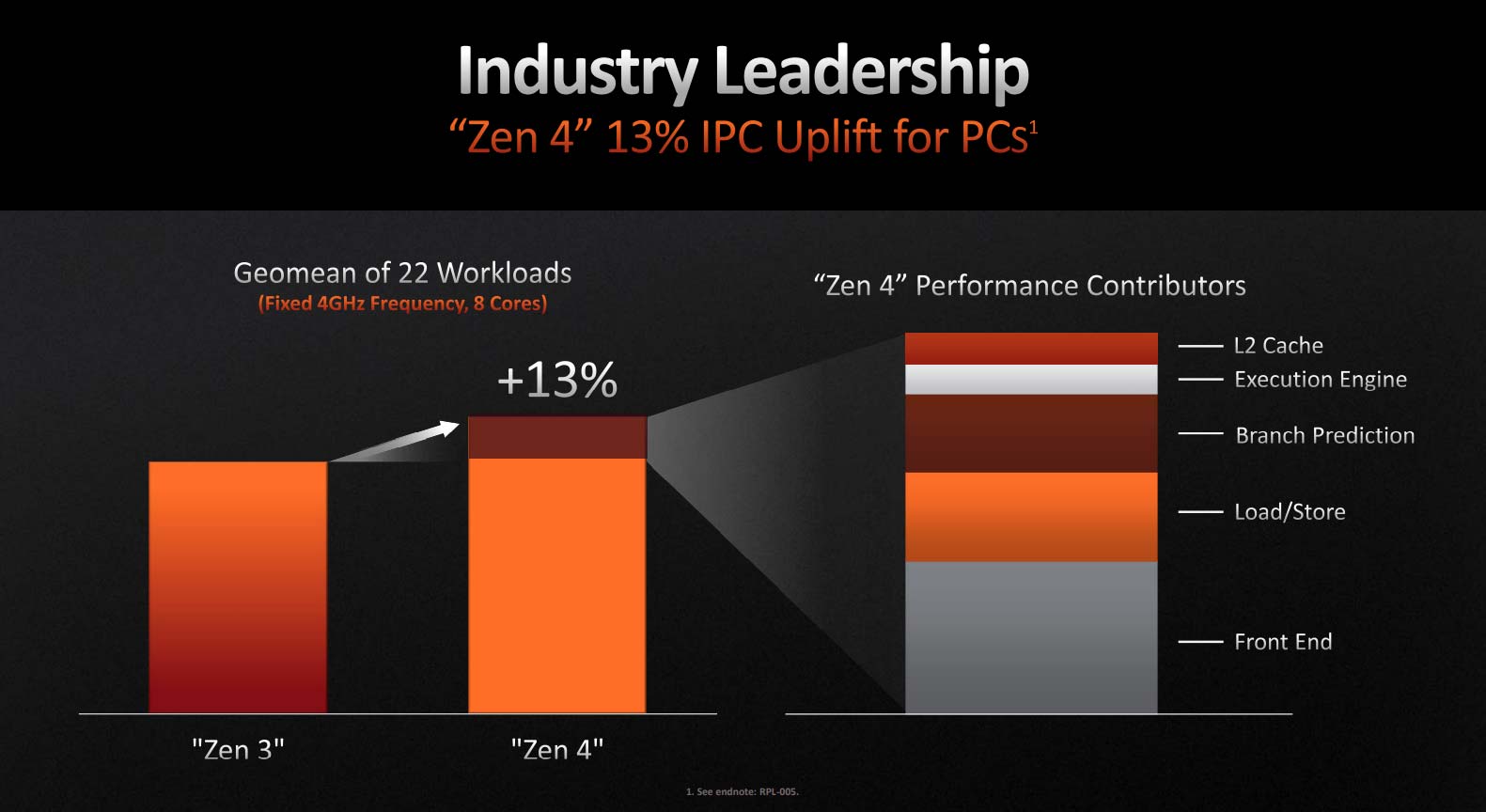
As frequency and not IPC is the main driver of Ryzen 7000 Series’ performance progression over the previous generation, we’re okay with the apples-to-apples uplift. It’s actually surprising how little extra performance is provided by the doubling of per-core L2 cache, bringing into question where it was necessary for this round of chips. Most of the gains – around 80 per cent or so – emanate from three areas: the front-end, load/store, and branch prediction.
This is telling insofar as most of the architectural tweaks derive from optimisations to what’s referred to as ‘feeding the beast.’
Front-end and branch prediction advances afford the largest portion of IPC gain – somewhere in the region of 60 per cent – and the key here is the increase in the size and processing ability of operation cache. The reasoning is simple enough because Zen 4, like its predecessor, keeps to a decode rate of four regular instructions per cycle, which is weak when the queue can dispatch six into the execution engines.
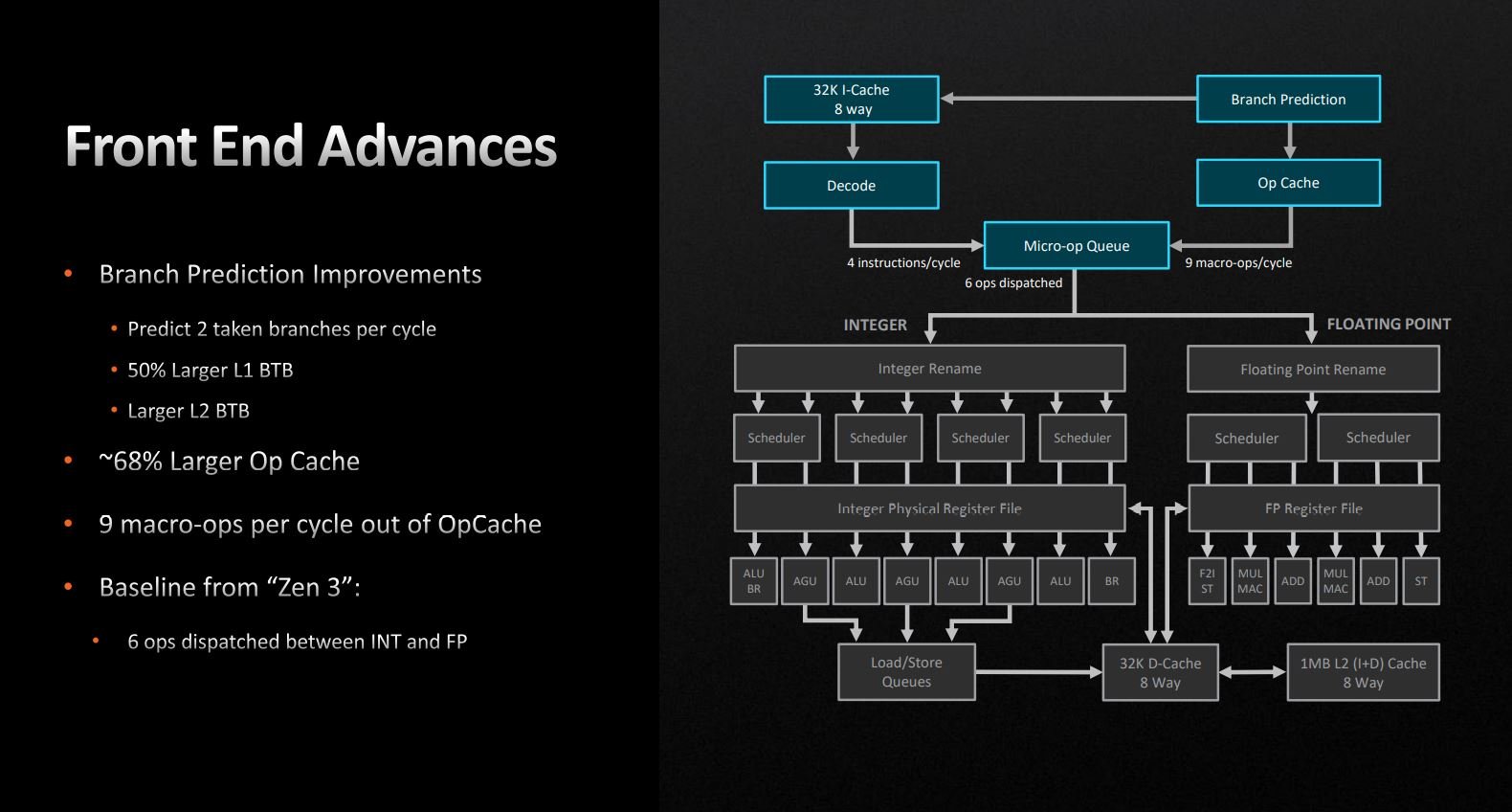
AMD got around this by having a 4K L0 op-cache on Zen 3, but this is increased to around 7K on Zen 4, alongside larger supporting buffers. And that’s been a hallmark of Zen evolution over the years. Zen 2, for example, had an L1 Branch Target Buffer (BTB) of only 512 entries; Zen 3 increased that to 1,024, and Zen 4 goes up to 1,536 entries. It wouldn’t surprise us one iota if Zen 5 doubles buffer and cache sizes again.
The easiest way to visualise the overall benefit is to imagine the front-end being a funnel into the core’s engine – the wider and more efficient it is, the better one can saturate the execution engines. Some of the most sought-after CPU architects are high-quality front-end merchants… and with good reason.
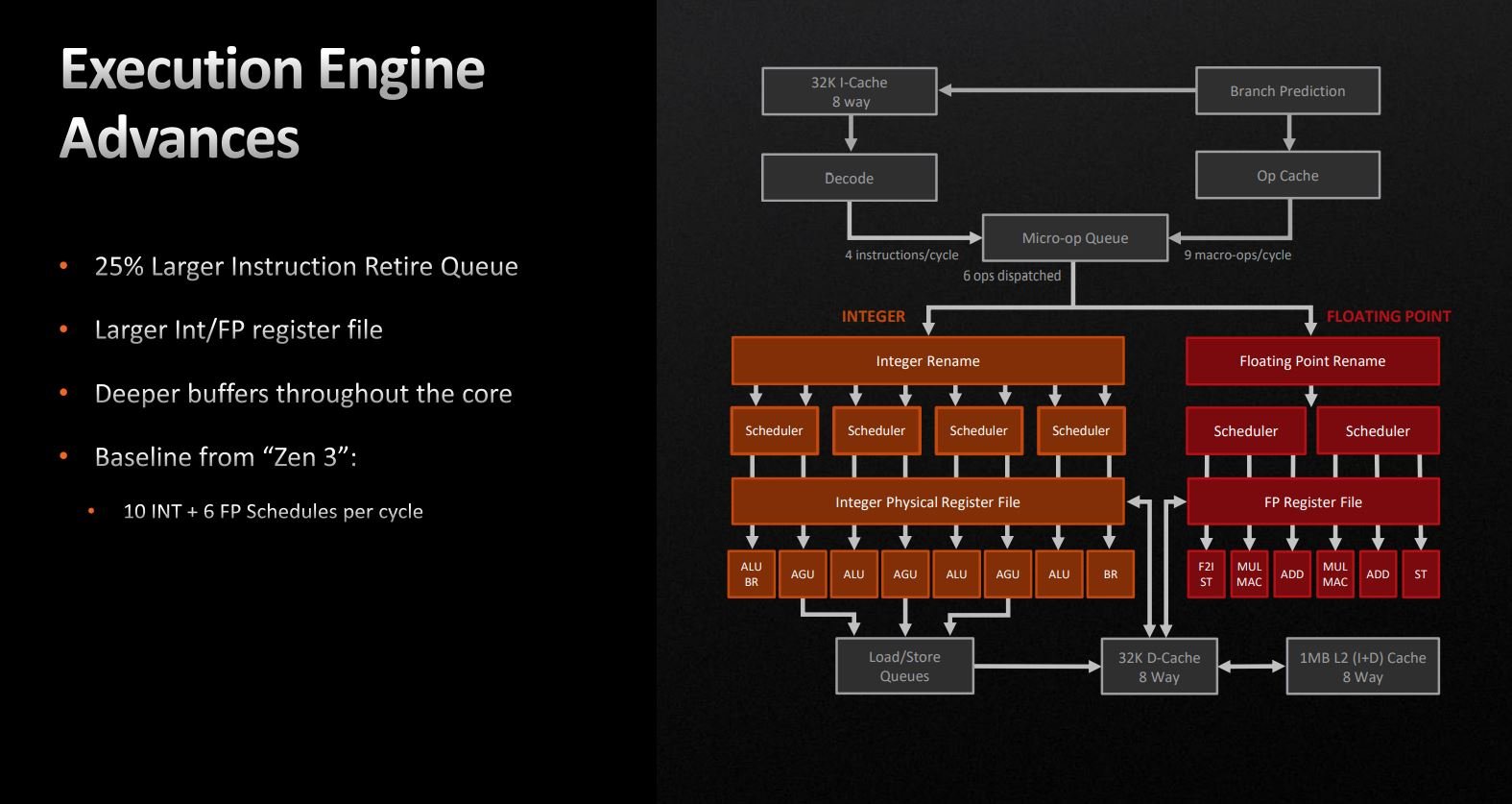
If you’re going to feed the beast more, it better have the stomach to digest bigger portions. This is where larger instruction retire queues and register files come into play. Adding them takes transistor space, explaining why Zen 4 is fundamentally larger than Zen 3, though it’s considered worth the expense as performance benefits outweigh the cost of implementation.
Moving on down to load/store units, Zen 4 goes, you guessed it, larger in areas that matter. Of particular note is the 50 per cent increase in L2 DTLB, though from what we can glean, it may be less associative.
This birds-eye view of key changes reinforces the message doled out above. AMD spends most of Zen 4’s additional resource into expanding buffers, caches and queues. The downside of doing so is increased latency out to larger, slower L2 and L3 caches, yet a few cycles can be masked by more in-flight processing.
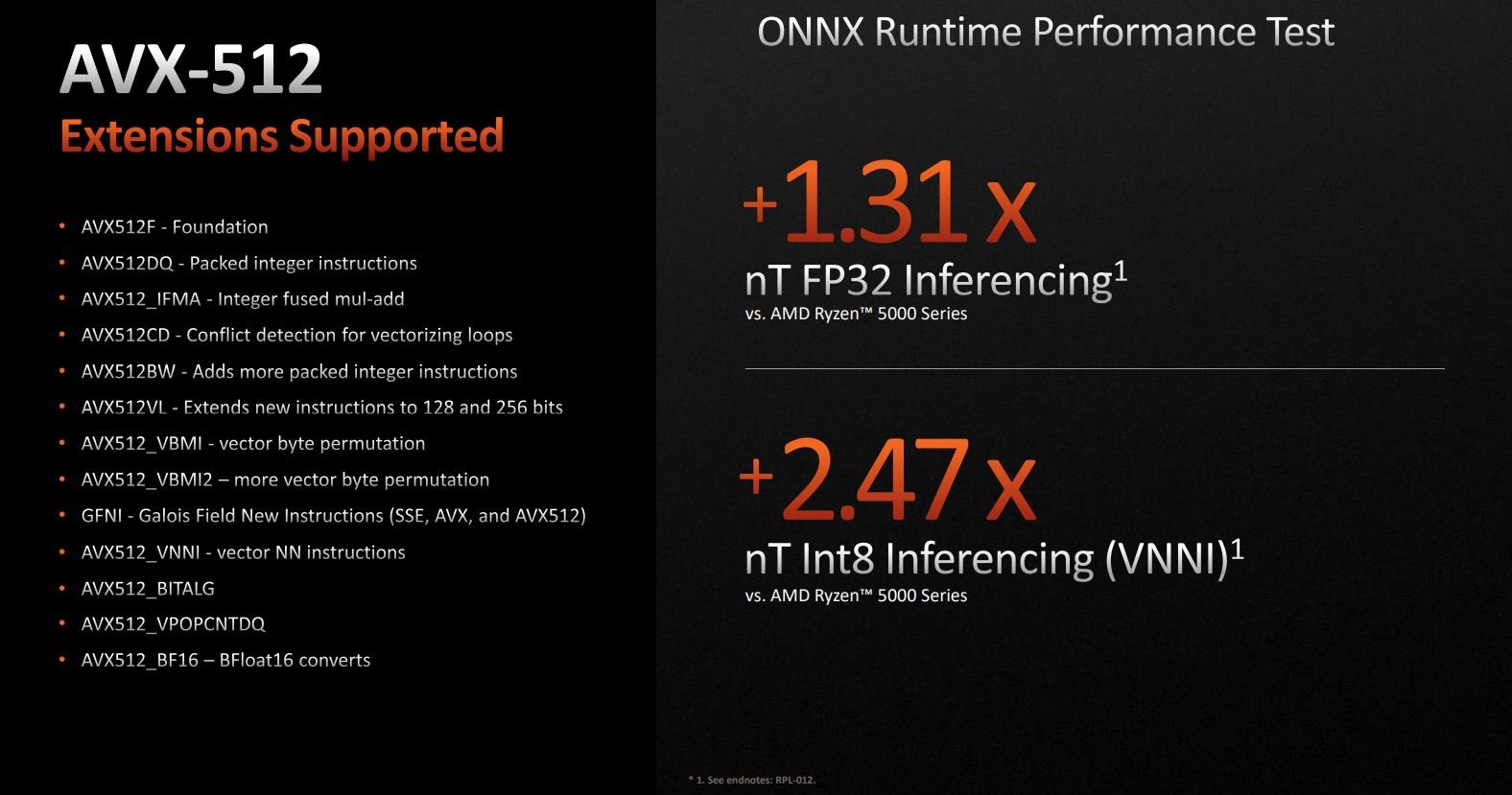
Did we forget to mention AVX-512 support? How remiss. Zen 4 does indeed support most of the feature-set but does so in an interesting way. Rather than go for a single, 512-wide ALU, which is the optimal but expensive way, AMD chooses to double-pump 256-bit-wide instructions. This approach is slower than a native implementation, of course, and Zen 4 does it this way, we imagine, in order not to hurt frequency too much. Full-on AVX-512 workloads have a habit of dragging speeds down and thermals up.
Going double-pump, though not ideal, is a good middle ground for consumer processors and fits neatly between regular AVX-256 and proper AVX-512 performance. Showing how noisome AVX-512 can be, Intel officially doesn’t support it on recent 12th Gen Alder Lake processors, which naturally puts AMD at an advantage in specific media workloads. Being fair, there’s little in the way of AVX-512-optimised software at the moment, yet AMD jumps on the mantra of if you build it, they will come.
Fight For Frequency
Design decisions within Zen 4 all tell one story. Architecture refinements play second fiddle to the quest for much higher frequency than available on Zen 3. According to all-round AMD genius Joe Macri, a multi-year collaboration with foundry partner TSMC, which has become closer over time, has enabled the duo to fine-tune high-performance 5nm silicon for elevated clocks.
The exact nature of the silicon remains unknown, but we do know AMD actually failed in the original aim of releasing Zen 4 with a top-bin speed of 6GHz. As 5nm matures, AMD may take very select dies and launch a wattage-unencumbered ‘Ryzen 9 7990X’ with that seminal frequency. But hey, 5.7GHz ain’t bad right out of the gate. Rival Intel appears to have beaten AMD to the 6GHz punch by sort of announcing the upcoming Core i9-13900KS.
Stratospheric single-thread speeds are all well and fine. We’re more impressed by the multi-core prowess of Ryzen 9 7950X, which hovers on the right side of 5GHz when everything is run at 11. Oops, letting the proverbial cat out of the benchmark bag there.
Packaging Opportunities – AM5
AMD’s mainstream chips since 2017 have been resident on the AM4 platform. Fantastic socket longevity provides ample upgrading opportunities over time, considered one of AMD’s key strengths – Ryzen 9 5950X, for example, can be run on select X370 motherboards from way back when – but is an obstacle when designing feature-rich, powerful platforms for the next five years. Something has to give, and in this case, AM4 is the sacrificial lamb.
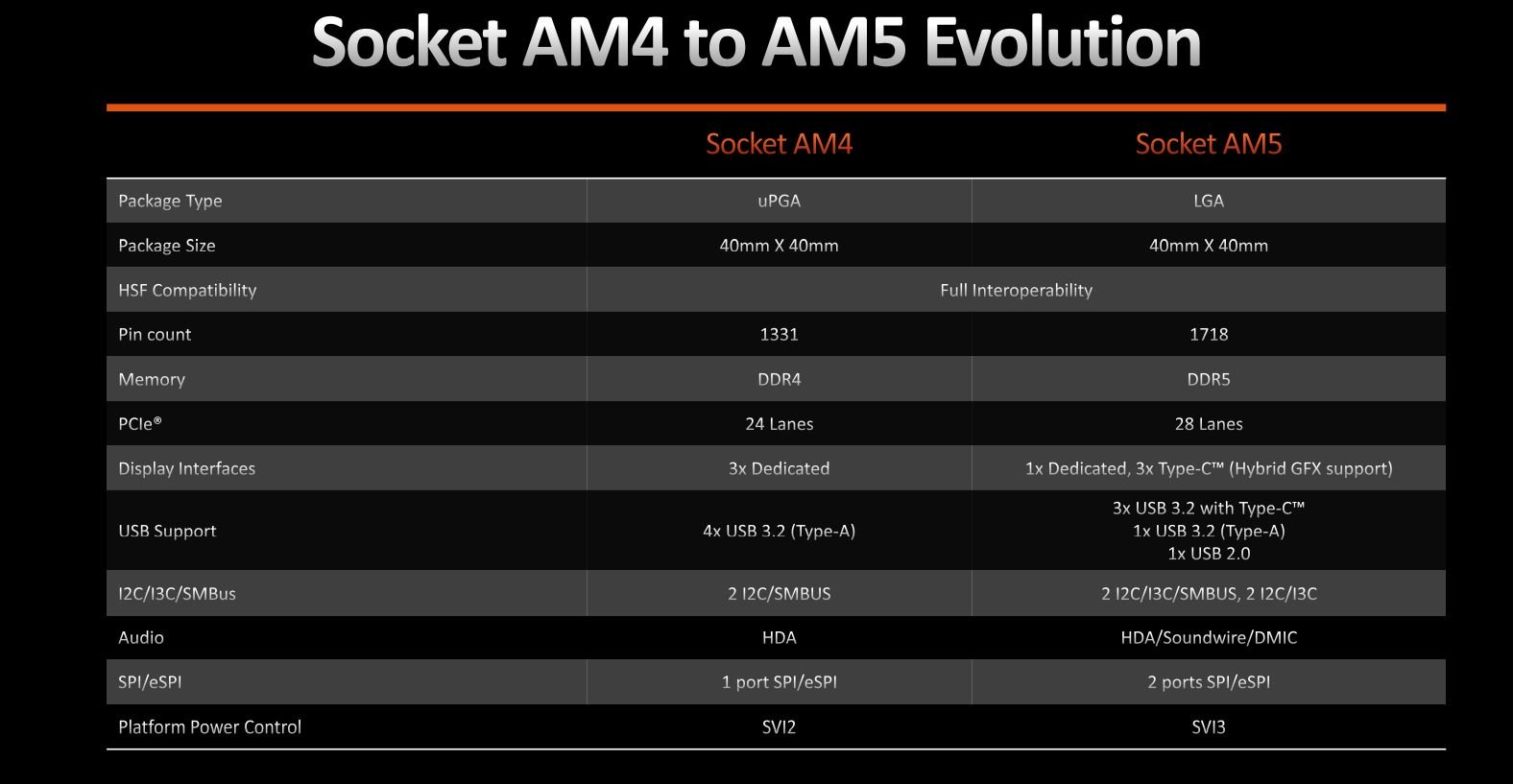
Which all leads me on to the second point about Ryzen 7000 Series. The chips use the AM5 form factor that’s just not compatible with gnarly, old AM4. You see, AMD transitions to an LGA1718 socket from PGA1334, meaning the pins are located on the motherboard, not the CPU, as is the case with AM4.
AM4, it has to be said, is the outlier in AMD’s processor stable. High-performance Threadripper (Pro) and server-optimised Epyc have been on an LGA footing since time immemorial; AM5 joins them. No more bent pins on the CPU, though watch out for dropping anything in the socket! In a concession to legion enthusiasts, AMD doesn’t change the 40mm x 40mm socket area, meaning you can re-use AM4 cooling. Another plus point is motherboard makers don’t have to completely redesign boards. A win-win.
Back on point, it’s the extra 29 per cent of pinnage that largely enables AMD to feed high-end beasts with more power. Sure, AM4 could scale high with lots of voltage, but it wasn’t designed to run close to 200W – AM5, on the other hand, laps it up. Extra routing pins also offer plenty of scope to add more features and performance in the future. With all that in mind, I believe shifting the entire mainstream ecosystem is the right idea, even if it doles out short-term pain by closing long-in-the-tooth upgrade paths.
DDR5 – The Only Show In Town
Five appears to be the magic number. AMD makes the move to DDR5 memory almost a year after Intel brought it to the mainstream with 12th Gen Core. Unlike its rival, Ryzen doesn’t bother with also carrying DDR4 compatibility. Want Ryzen 7000 Series, you better budget for DDR5 memory.
The good news is DDR5 memory is becoming more affordable each passing month. A high-performance 32GB kit is available for around £200, which is about 50 per cent more than the cost of enthusiast-grade DDR4. £70 premium for memory is small beer when considered in the wider sense, so whilst DDR4 support would have been nice, especially for budget builds featuring lower-end Ryzen 7000 chips, it ain’t a deal breaker.
One man’s dual-channel DDR5 implementation isn’t the same as another’s. AMD’s distils down as follows:
| Configuration | Maximum speed |
|---|---|
| 1x single-rank | 5,200MT/s |
| 1x dual-rank | 5,200MT/s |
| 2x single-rank | 3,600MT/s |
| 2x dual-rank | 3,600MT/s |
The takeaway is simple. Sticking four modules into a motherboard results in officially supported speed dropping from a nice 5200MT/s to just 3,600MT/s. Sure, most enthusiast boards will offer much higher speeds, and run stably at that, yet the steep frequency drop-off isn’t ideal. Put simply, run with two modules if you can. Now where are those 64GB modules running at 6600MT/s?
Getting granular on a platform level, you may remember Ryzen 5000 Series CPUs tied the internal memory clock speed to Infinity Fabric speed and integrated memory controller. This changes on Ryzen 7000 Series because of the higher speeds offered by DDR5. In practise, internal RAM speed is still run on a 1:1 ratio with the IMC but the Fabric clock drops down to a 3:2 ratio.
Let’s take an example of DDR5-5200 memory. It actually runs at 2,600MHz internally, which ties to the frequency of the IMC (also 2,600MHz). Infinity Fabric, meanwhile, runs at 1,733MHz on a 3:2 ratio. Put simply, getting the IF clock to 2,600MHz is not going to happen.
You may have read about a sweet spot memory speed of DDR5-6000, and there’s good reason why that works well. The IMC also scales to 3,000MHz in that instance while IF chugs along at 2,000MHz. All good. Running past an internal 3,000MHz DDR5 clocking causes the IMC to halve in speed, while IF fidgets between 1,850-2,100MHz.
The key to fast running is symmetry. You may find application performance is marginally slower with DDR5-6400 as the IMC speed is cut to only 1,600MHz.
Chipset Bonanza
Motherboard makers lick their chops when a new socket comes out. Catering for the enthusiast first, AMD’s partners are now releasing X670E and X670 chipsets. Boards are expected to cost from £200 and scale up to, well, more paper than most wallets hold.
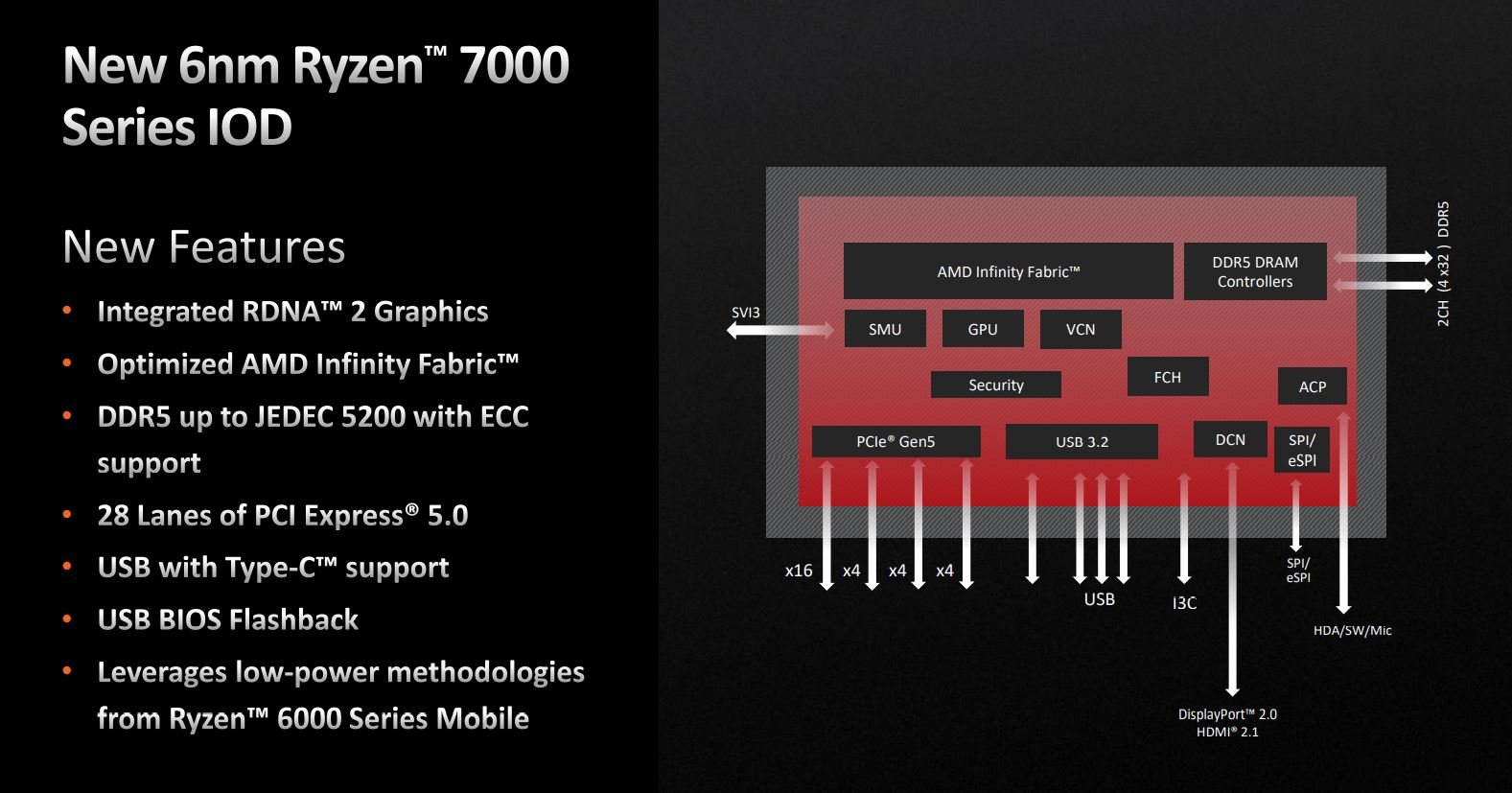
A lot of the expansion goodies are held on the IOD section of the CPU, and you will receive this connectivity mana, illustrated above, irrespective of chipset employed. Compared to Ryzen 5000 Series processors, which are still considered rich in features, AMD increases PCIe lanes from 24 to 28. That’s only half the story as Ryzen 7000 Series upgrades them to speed-loving PCIe 5.0.
This actually shakes out simply. You now have one more CPU-integrated PCIe x4 link ostensibly for additional storage, run at up to PCIe 5.0 for upcoming SSDs. In a nod toward legacy support and BIOS flashback updates, AMD further adds a single general-purpose USB 2 port.
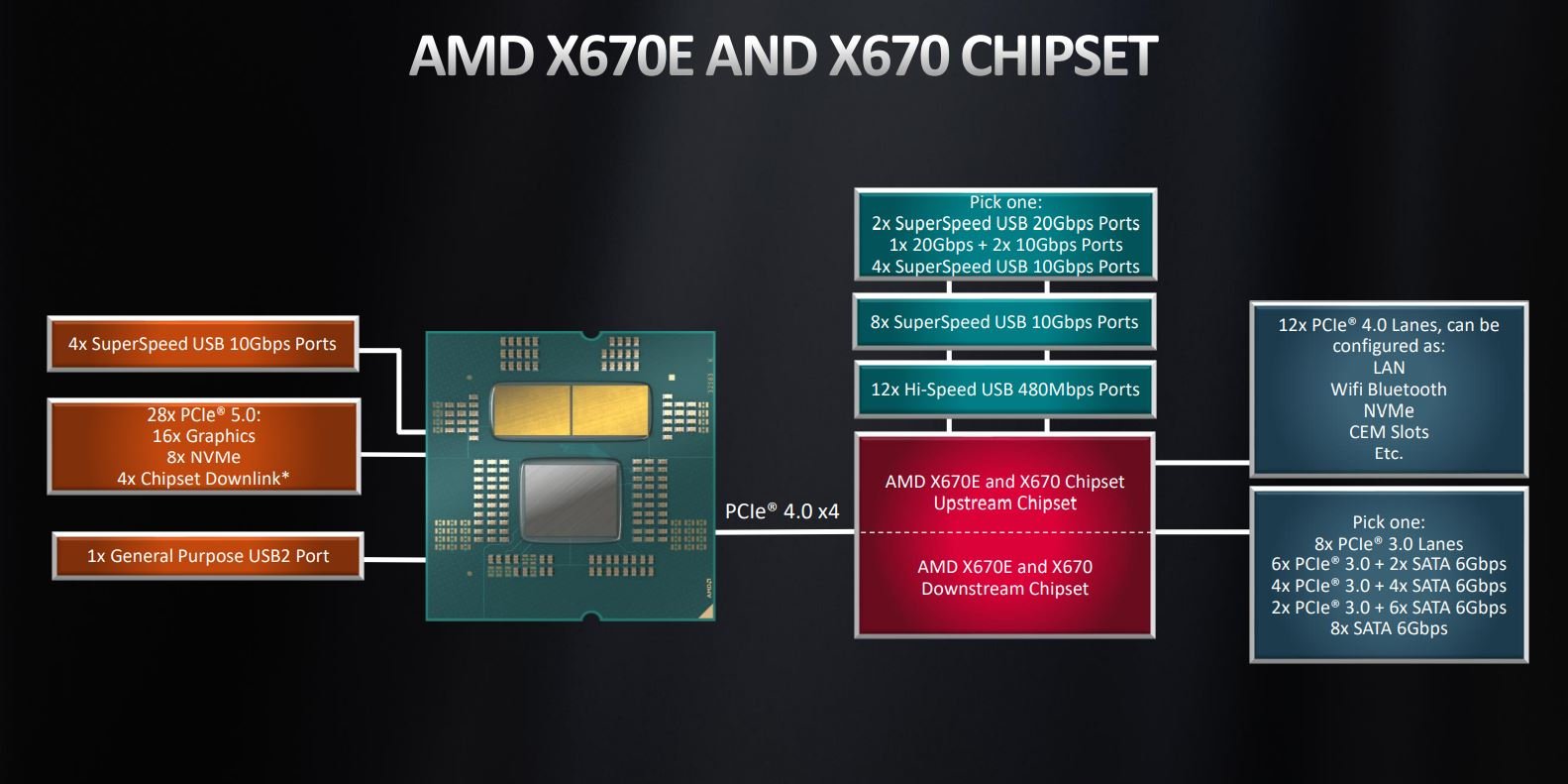
Four of the aforementioned 28 lanes emanating from the IOD portion of the chip are purposed into PCIe 4.0 for connecting the CPU to the chipset. And it is a set of chips this time around. Look closely to determine X670E and X670 utilise a two-chip solution. Known internally as Promontory 21 and built by ASMedia, both are not connected directly to the CPU. Rather, only the first is via the shown PCIe 4.0 x4 link. The second daisy-chains to the first via another PCIe 4.0 x4 internal link and has to run through it to pass data to the processor. A downside is potentially higher access latency on the second Prom 21, but an obvious benefit of a two-chip solution is that one can double-up on connectivity without needing a single, super-large solution. Once you understand this, the decent connectivity increase in supported devices compared to X570 makes implicit sense.
New X-series is therefore able to go real heavy on USB. Remember X570 natively supported up to 12 ports – eight USB 3.2 G2, four USB 2.0 – X670/E’s two-chip solution offers up to 20 of various speeds, with the option, for the first time, to have a couple of 20Gbps rolled into the mix. Nice.
Looking across, general-purpose lanes increase from eight to 12, and AMD throws in heaps of PCIe 3.0, as well. If you’ve got the chip features and bandwidth, why ever not. Both run at around 7W full chat, which when spaced out on a motherboard is okay for operating without the fans we saw on all original X570 boards. Good news.
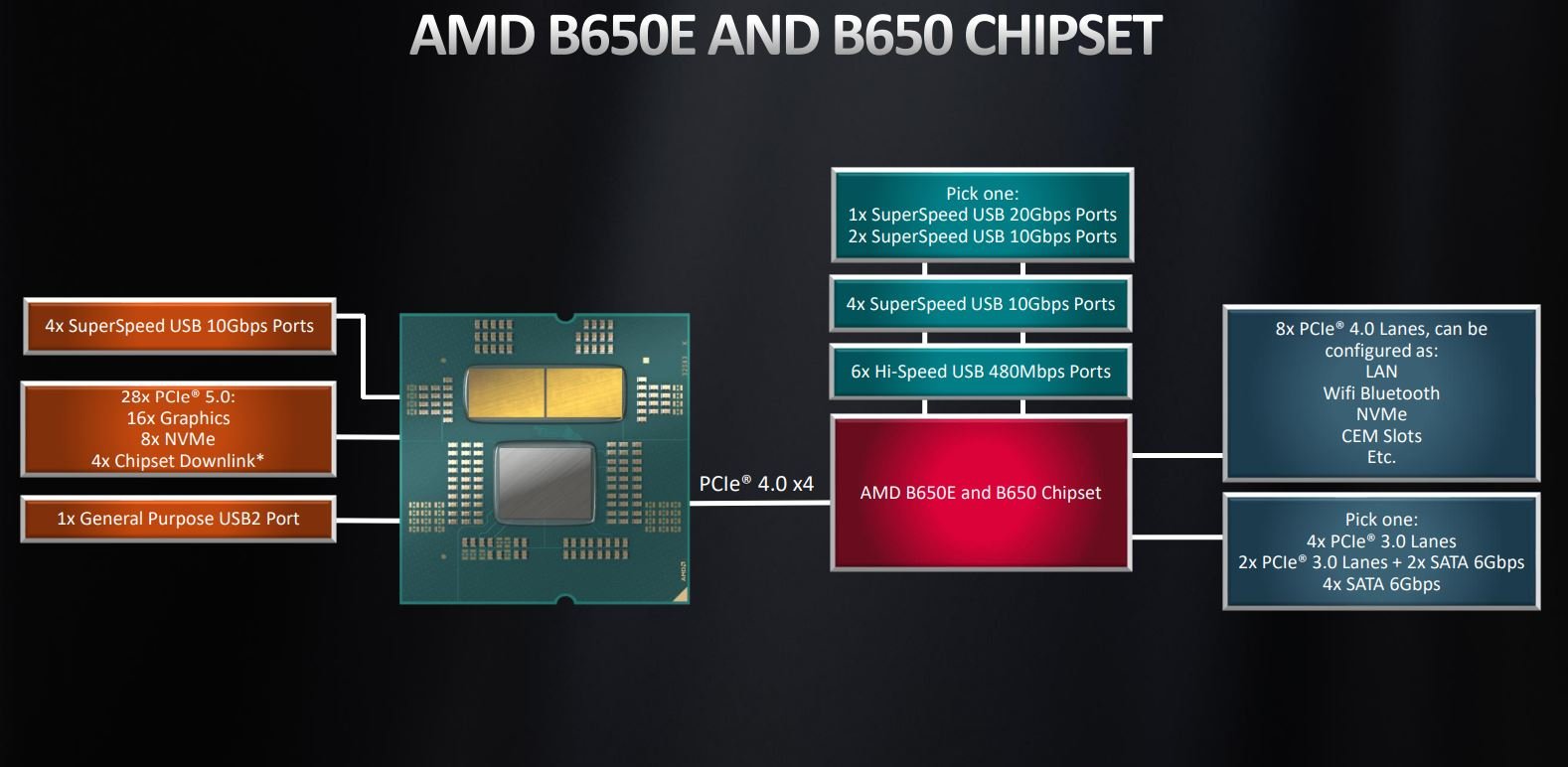
Motherboard manufacturers won’t need to add many discrete chips for a fully-fledged board, and it’s only USB 4 that’s conspicuous by its absence. Even that’s not quite the headache that it could have been; most motherboard guys with premium offerings will use either the ASMedia ASM4242 or Intel Maple Ridge two-port USB 4 host controllers running off spare CPU PCIe lanes.
Ryzen 7000 Series Models
| Model | Cores / Threads | TDP | L3 Cache | Base Clock | Boost Clock | Launch MSRP |
|---|---|---|---|---|---|---|
| Ryzen 9 7950X | 16 / 32 | 170W | 64MB | 4.7GHz | 5.7GHz | $699 |
| Ryzen 9 7900X | 12 / 24 | 170W | 64MB | 4.7GHz | 5.6GHz | $549 |
| Ryzen 7 7700X | 8 / 16 | 105W | 32MB | 4.5GHz | 5.4GHz | $399 |
| Ryzen 5 7600X | 6 / 12 | 105W | 32MB | 4.7GHz | 5.3GHz | $299 |
Ryzen 9 7900X maintains the 12C24T philosophy adopted by 5900X and 3900X(T), released over the past three years. Improvements in architecture and frequency have negated the need for adding to the core-and-thread count, AMD says, yet Intel’s relentless pursuit of desktop dominance is at odds with AMD’s more conservative approach.
Ensuring 7900X is able to mete out performance in spades, AMD’s 170W TDP and associated 230W PPT enables the chip to run all the way up to 5.6GHz on a few cores. It’s sensible to assume the review chip is built from dies that don’t quite make the 7950X grade. In that respect, the two top-tier CPUs are composed in identical fashion, meaning a two-CCD setup carrying either six (7900X) or eight (7950X) cores each. Both models carry the full complement of 64MB L3 cache, as well.
Launch pricing of $549 matches that of last-generation 5900X and is $50 dearer than 3900X and XT. Fierce competition in today’s market sees the processor now readily available for $440 – a whopping 20 per cent discount just months after launch – which equates to roughly £460 inc. VAT on these here shores.
The CPU
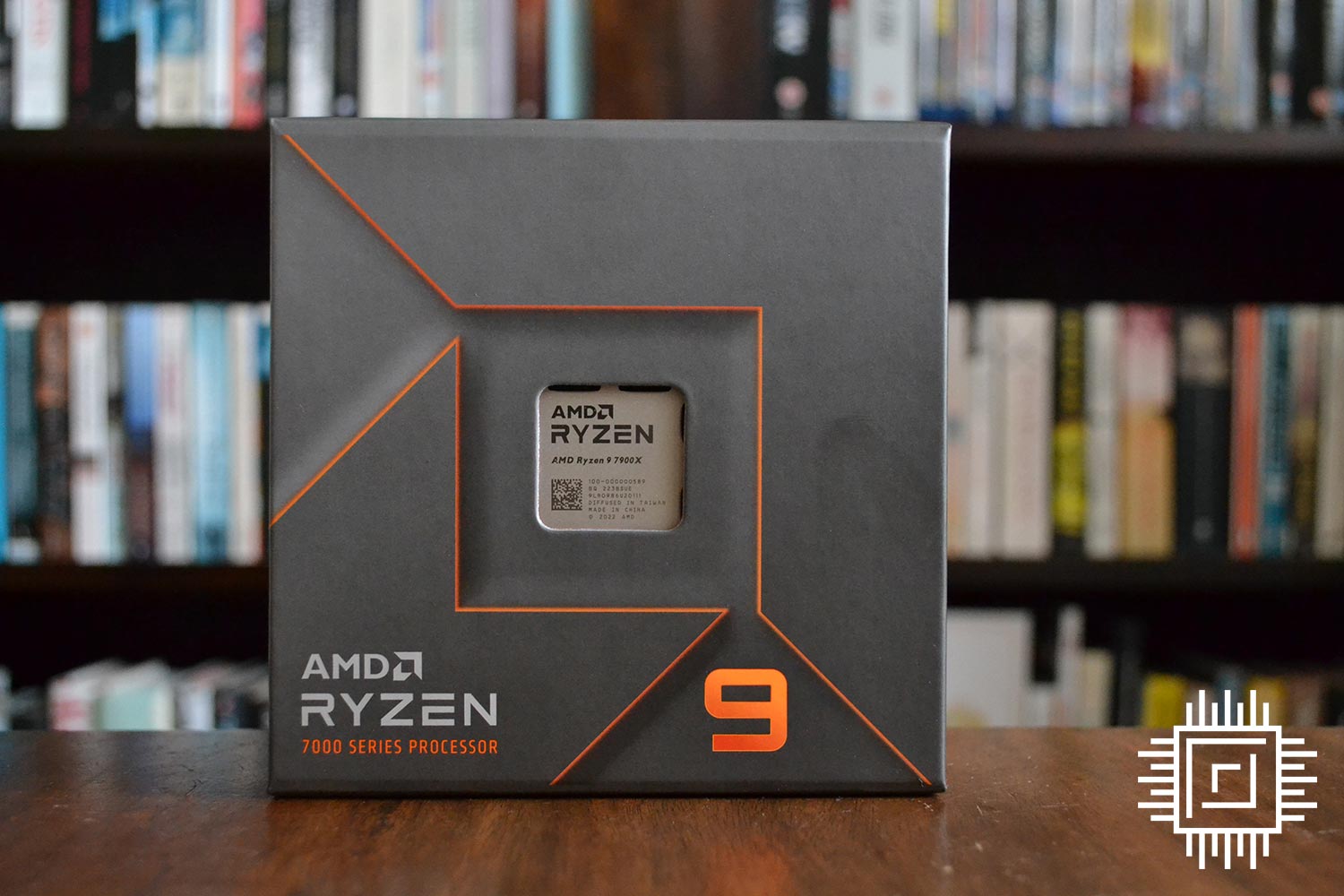
The attractive box hides the fact that no current 7000 Series processor ships with a cooler in the package. The same is true of Intel 13th Gen Core chips, too, so we can’t look unfavourably at AMD for the omission.
| Core i7-13700K | AMD Ryzen 9 7900X | AMD Ryzen 7 7700X | |
| Cores/threads | 16/24 | 12/24 | 8/16 |
| Peak frequency | 5.4GHz | 5.6GHz | 5.4GHz |
| L2+L3 cache | 54MB | 76MB | 40MB |
| Max TDP/PPT | 253W | 230W | 142W |
| Recommended price | $409 | $549 | $399 |
It is useful to compare exactly where Ryzen 9 7900X fits into the wider landscape. There’s an undeniable performance benefit from switching up from Ryzen 7 7700X to Ryzen 9 7900X, and it is reasonable to assume the review processor is up to 50 per cent faster in scenarios where all cores and threads are tasked. In that respect, the $399 to $549 price hike is justified.
Yet it’s the impressive Core i7-13700K which is causing AMD the most worry, leading to 7900X price reductions from retailers. Armed with a $409 price tag and equipped with considerable firepower of its own – 16 cores and 24 threads of Raptor Lake muscle – the Core i7 is a serious challenger.
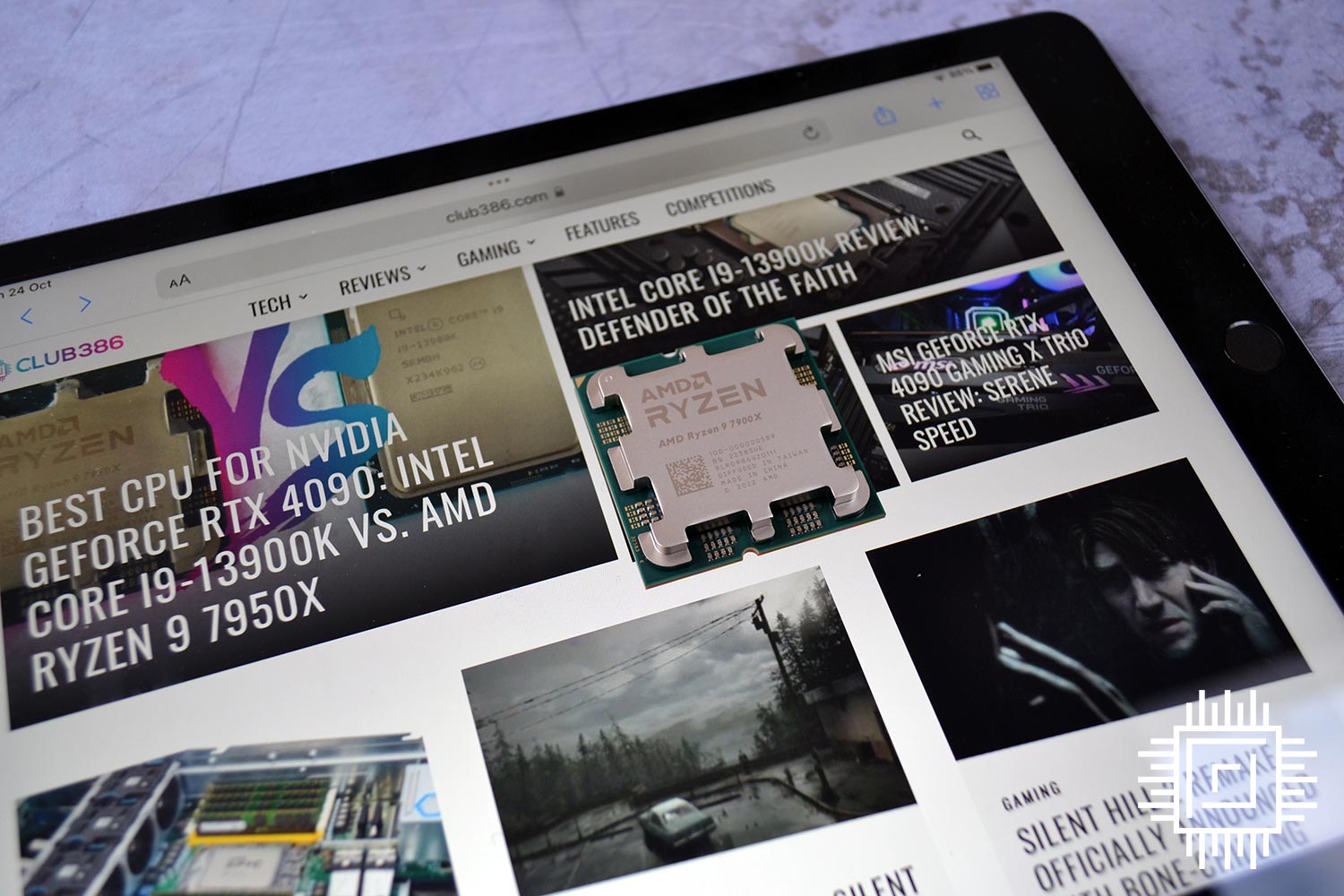
Getting the most out of the processor, tests are carried out on top of an Asus ROG Crosshair X670E Hero motherboard, 32GB (2x16GB) of G.Skill Trident Z5 Neo EXPO memory operating at official specifications of DDR5-5200 (CL30).
The supporting cast, also common between all processors, consists of an Nvidia GeForce RTX 3080 FE graphics card, Seagate FireCuda 530 2TB SSD, and Noctua NH-D15 cooling. The ensemble is powered by a be quiet! Dark Power 13 1,000W PSU. The review chip is run at AMD-mandated settings of 170W TDP and 230W PPT.
Two upcoming comparisons are most important. The first is the performance uptick of Ryzen 9 7900X over last-gen Ryzen 9 5900X, and analysis of improvements will inform us of AMD’s out-of-core innovation as both use a 12C24T philosophy. The second is against the aforementioned Intel Core i7-13700K, priced at a more commanding $409.
Performance
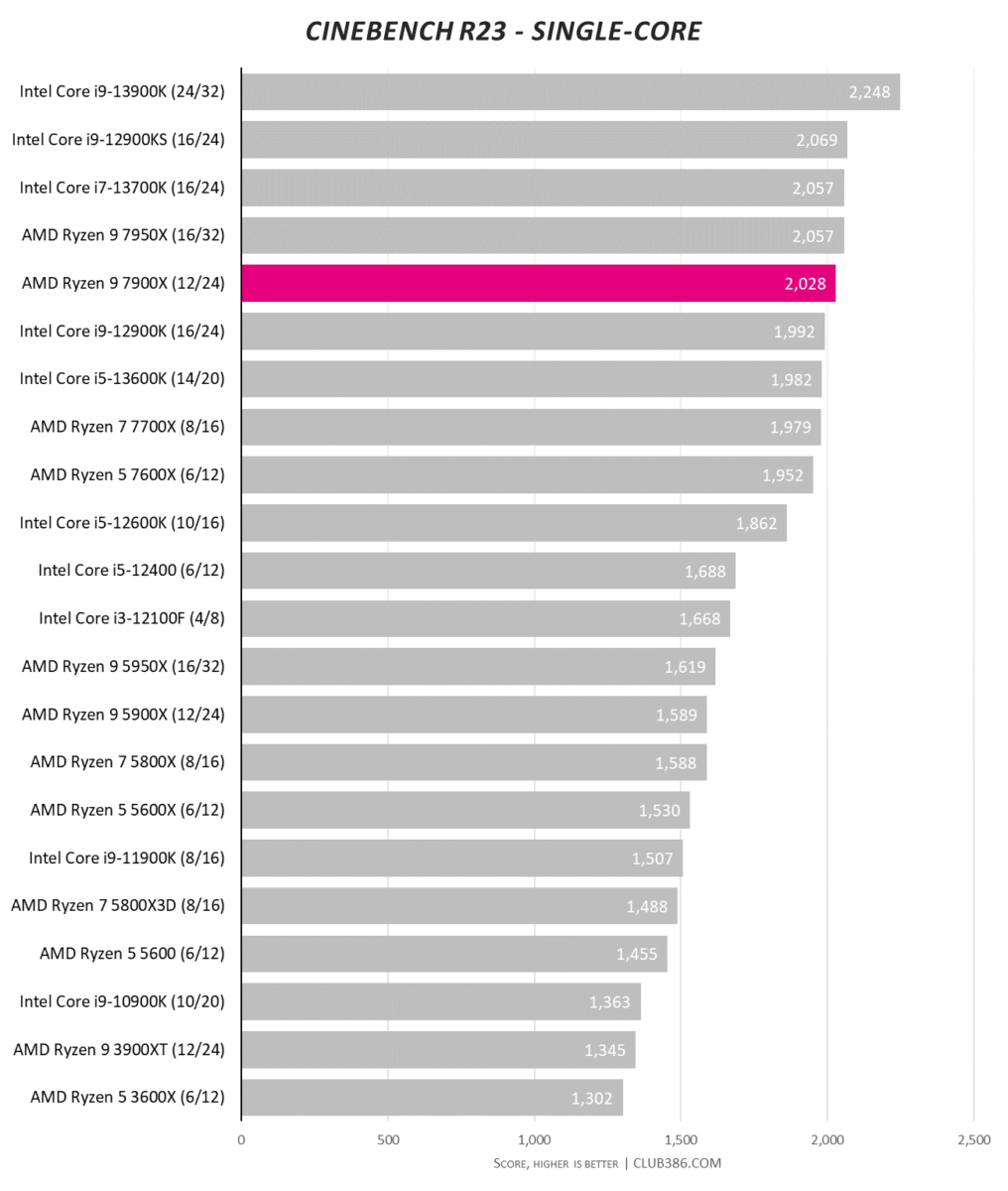
A 28 per cent single-thread gain over the last-generation Ryzen 9 5900X is pretty damn impressive. Twin drivers of improved IPC and higher frequencies combine well, making Ryzen 7000 Series the first AMD desktop chips to exceed the 2,000-mark barrier.
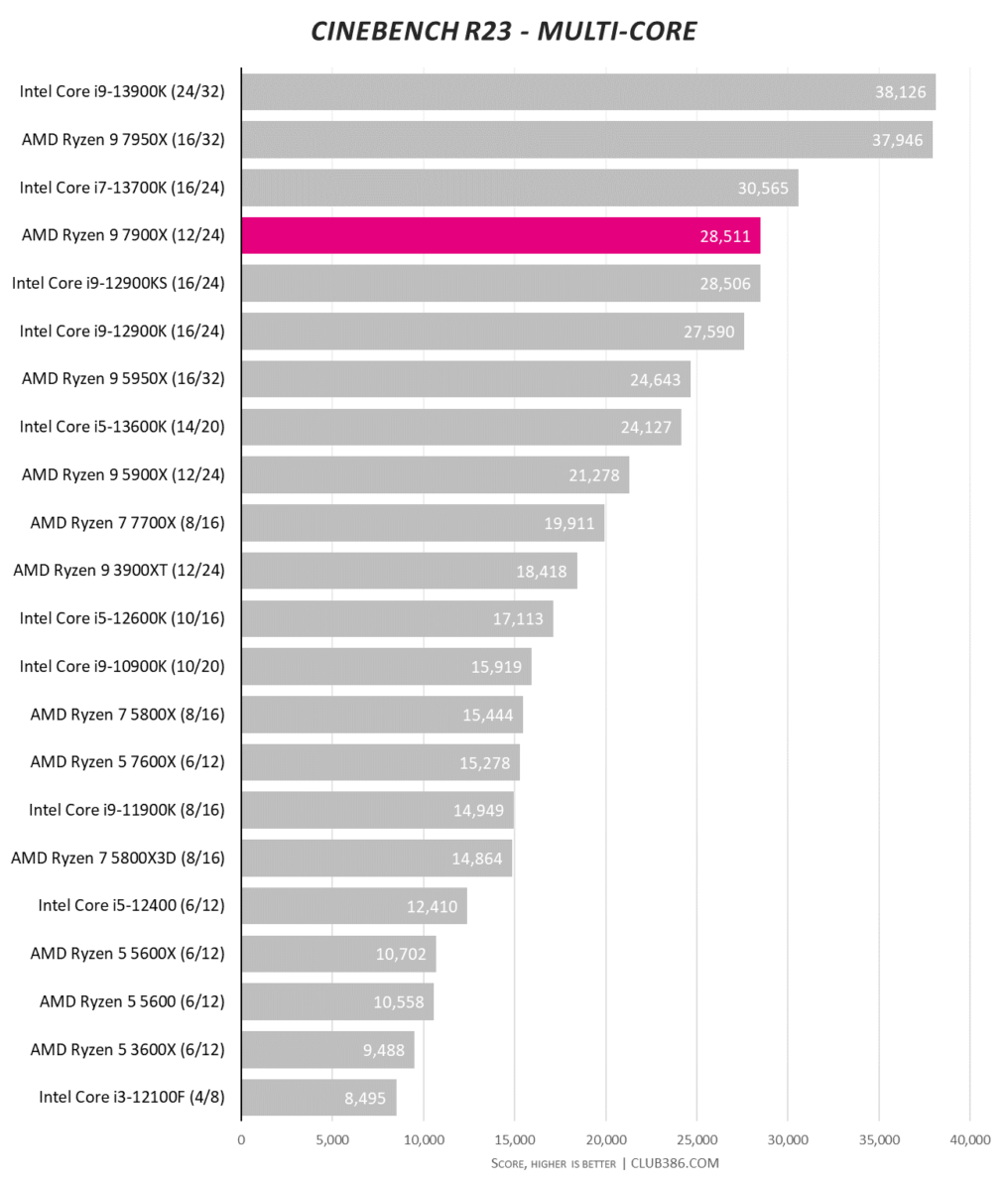
34 per cent faster than the also-12C24T 5900X and also speedier than head honcho 5950X from the last generation, we can’t actually quibble at the gains made by AMD from 5000 Series to 7000 Series. Considered in isolation, Ryzen 9 7900X is fine chip for heavy-duty workloads.
The trouble comes by way of Core i7-13700K, which is both faster and cheaper than 7900X.
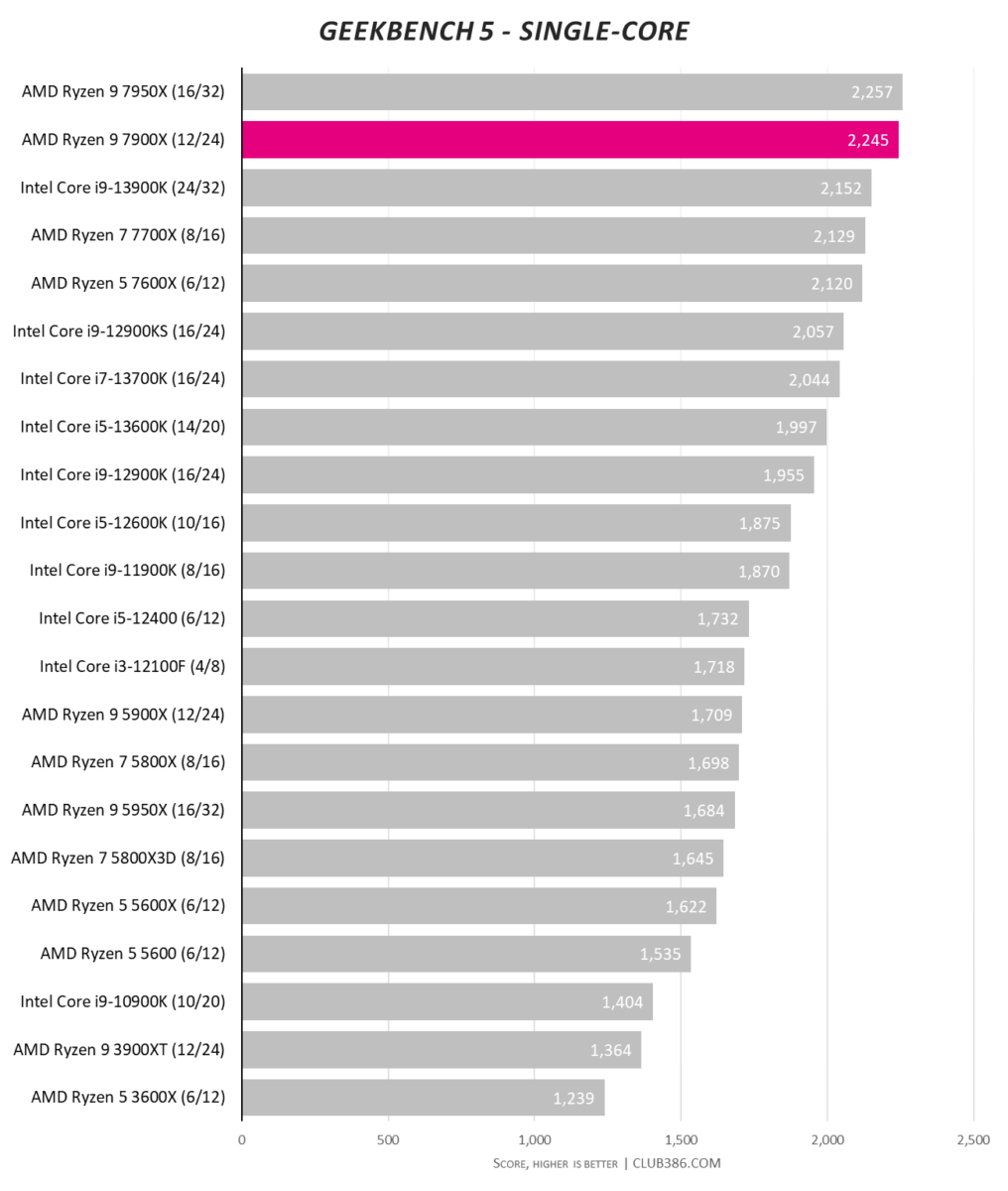
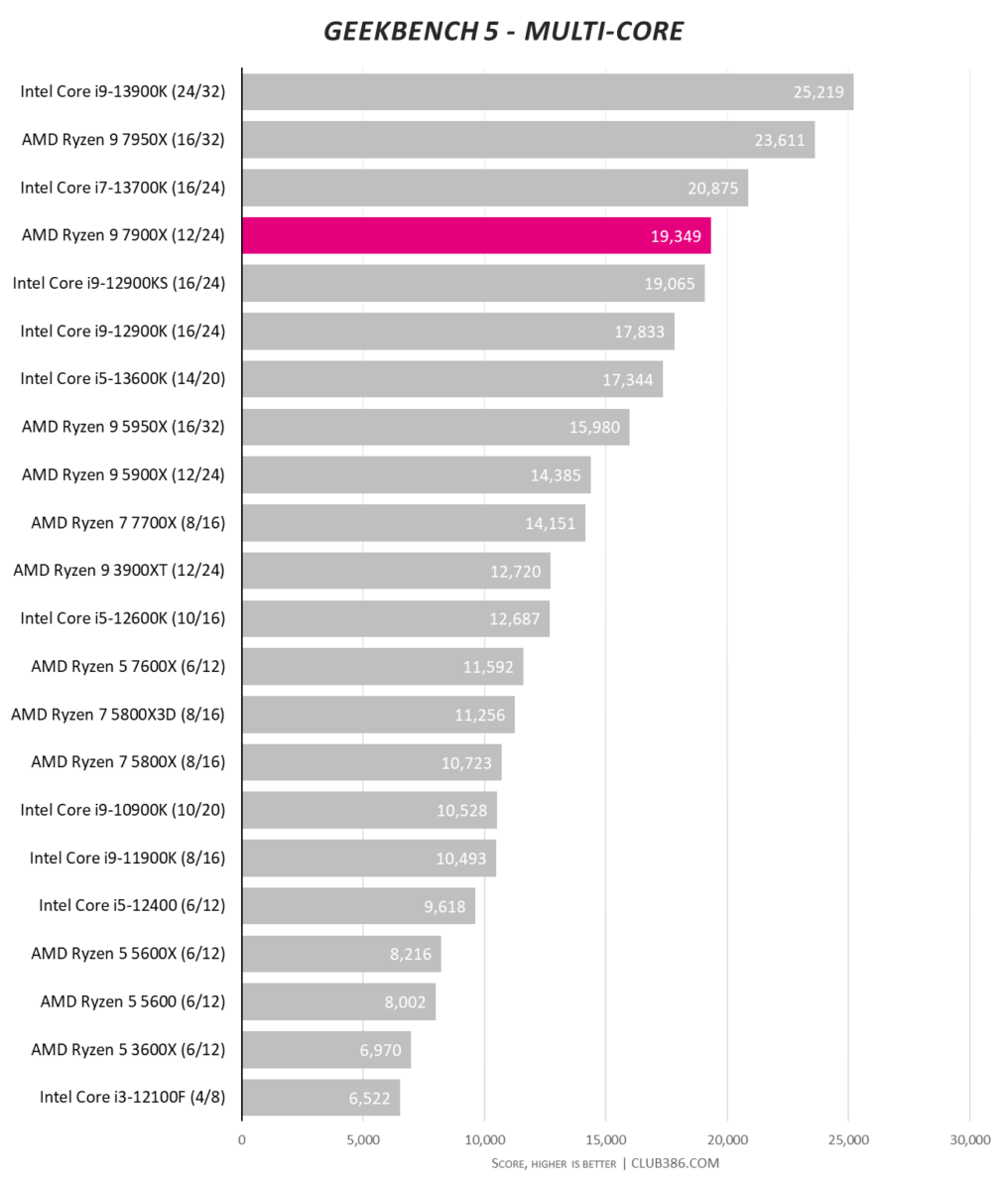
Excellent numbers posted once again, and Ryzen 9 7900X has the beating of every processor from the last generation.
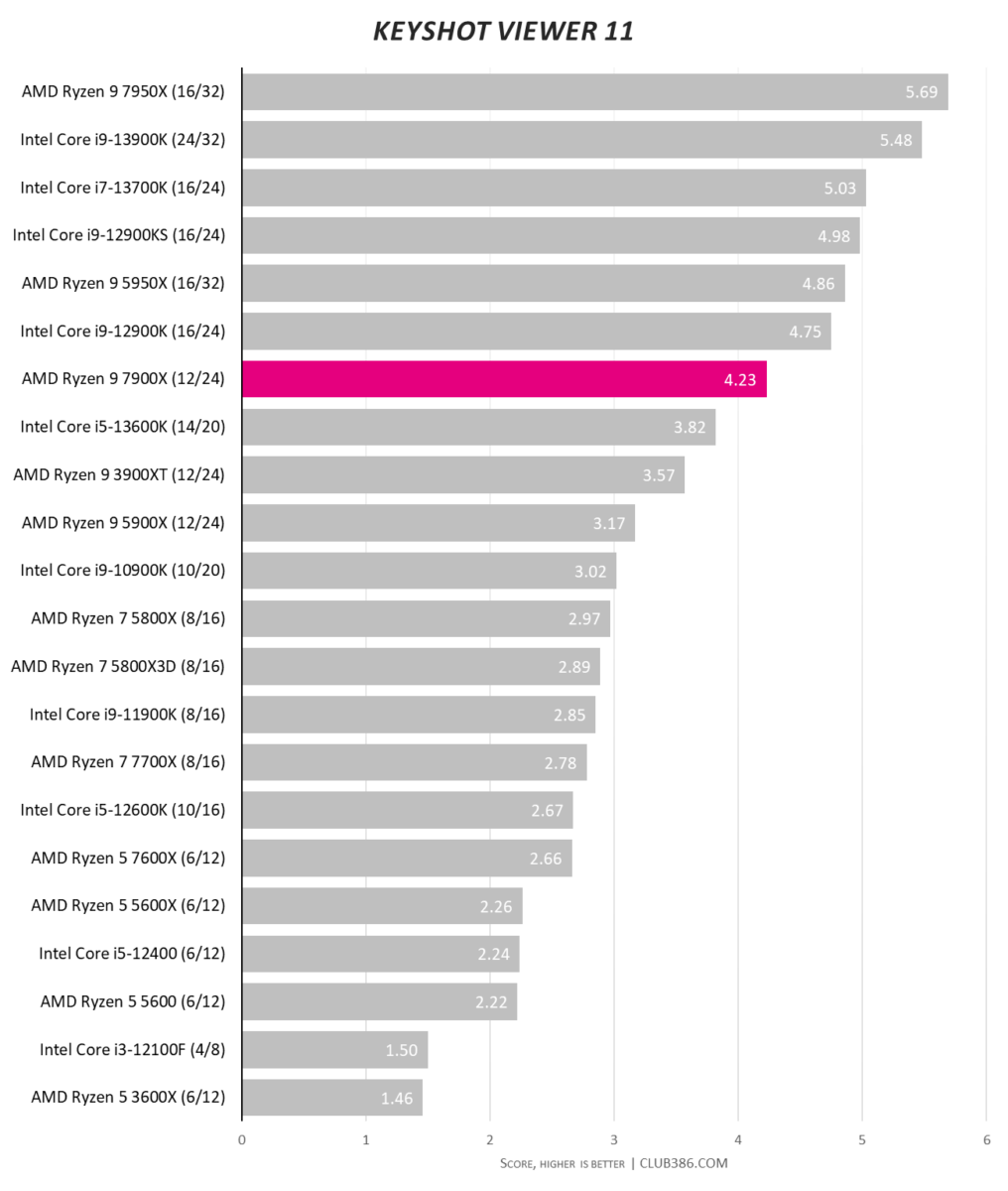
| Core i7-13700K | AMD Ryzen 9 7900X | AMD Ryzen 7 7700X | |
|---|---|---|---|
| 7-zip 19.00 (HIB) | 157,712 MIPS | 170,613 MIPS | 119,843 MIPS |
| Blender 3.3.0 (HIB) | 454.8 samples | 462.2 samples | 311.4 samples |
| V-Ray 5.0.20 (HIB) | 21,430 samples | 22,003 samples | 15,100 samples |
| y-cruncher 9513 (LIB) | 148.1 seconds | 138.5 seconds | 167.8 seconds |
We can take a more detailed look at further multi-core performance from the trio of chips identified previously. Ryzen 9 7900X wins all tests, though the margin of victory is sparing over Core i7-13700K.
Memory
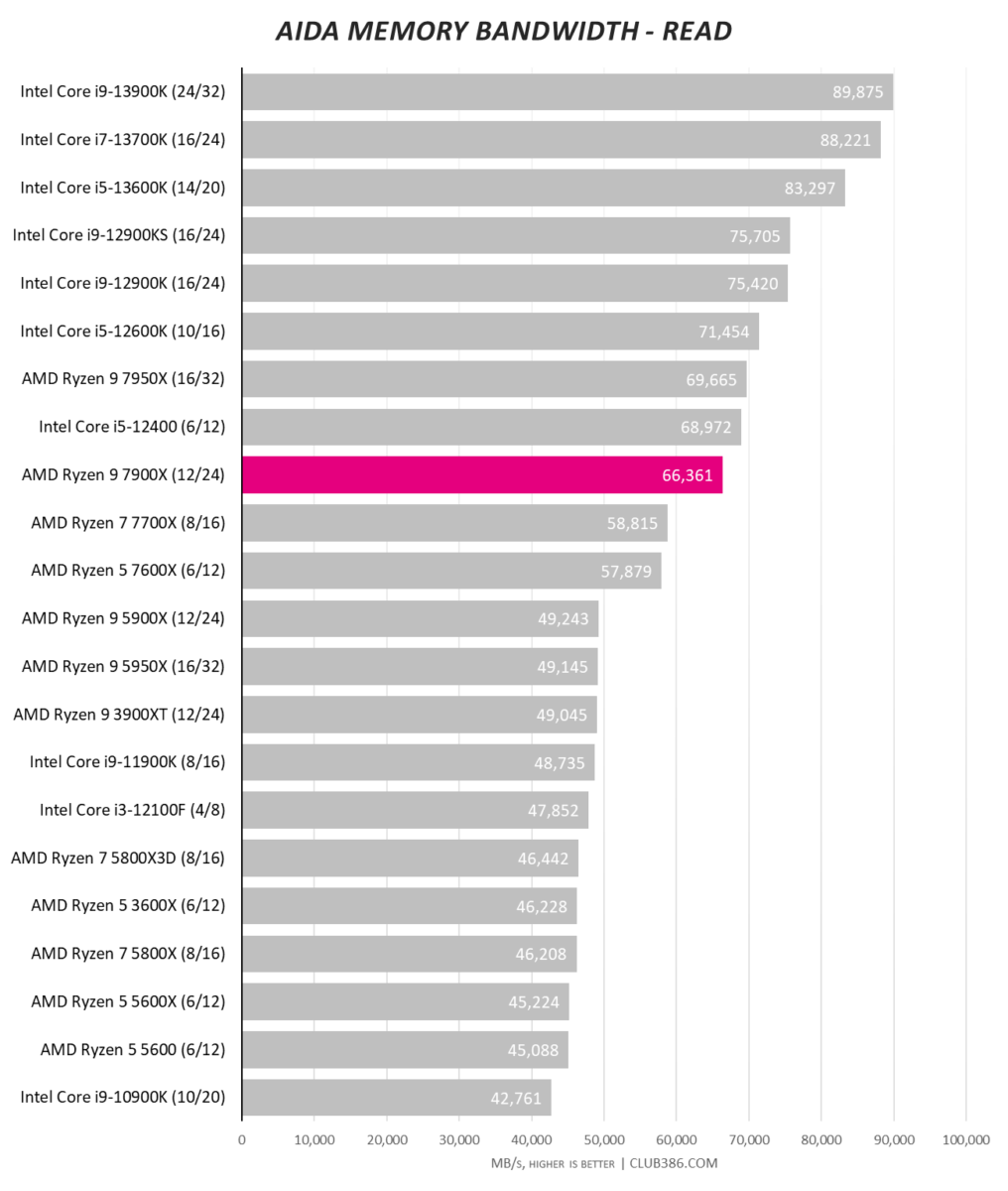
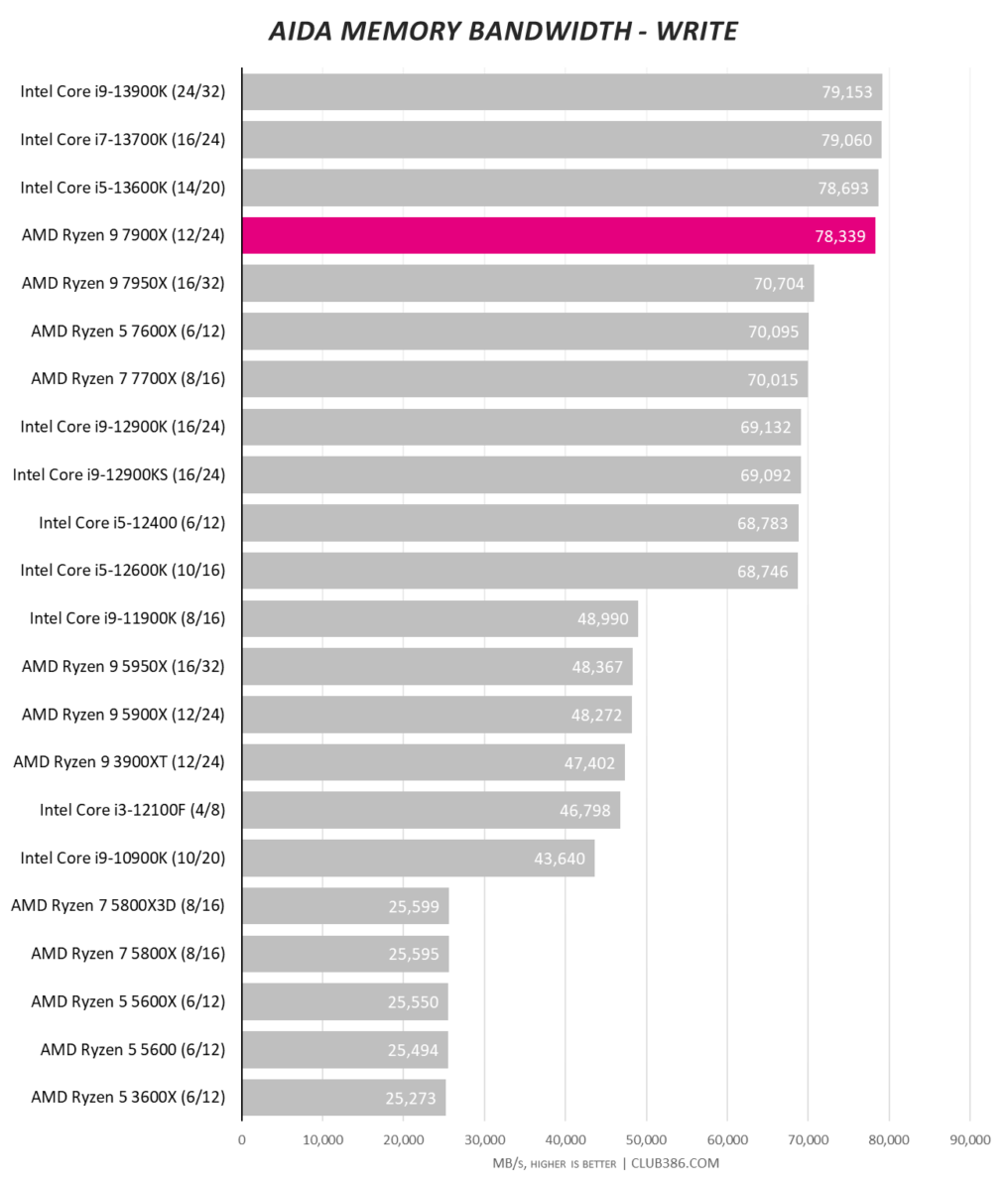
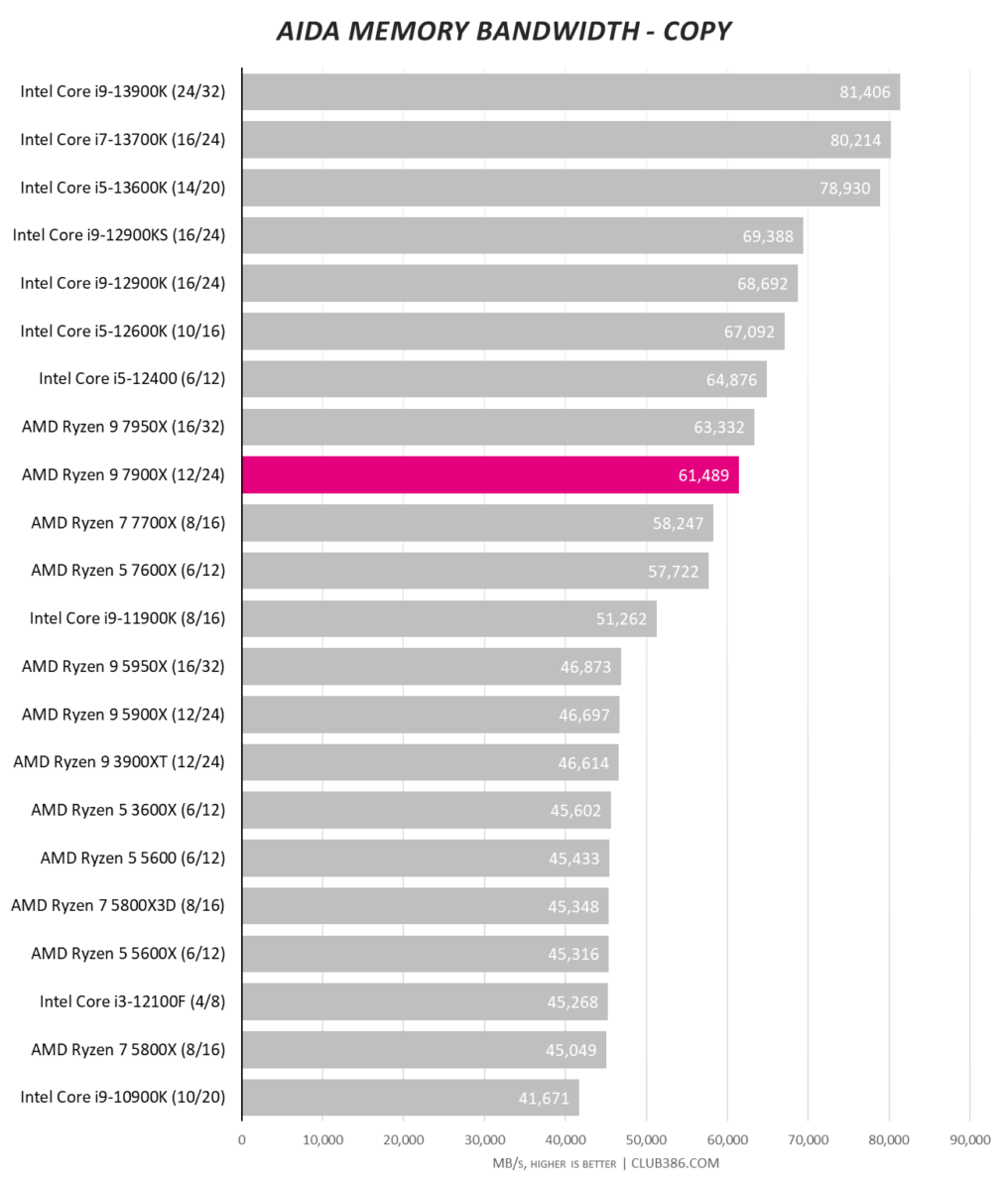
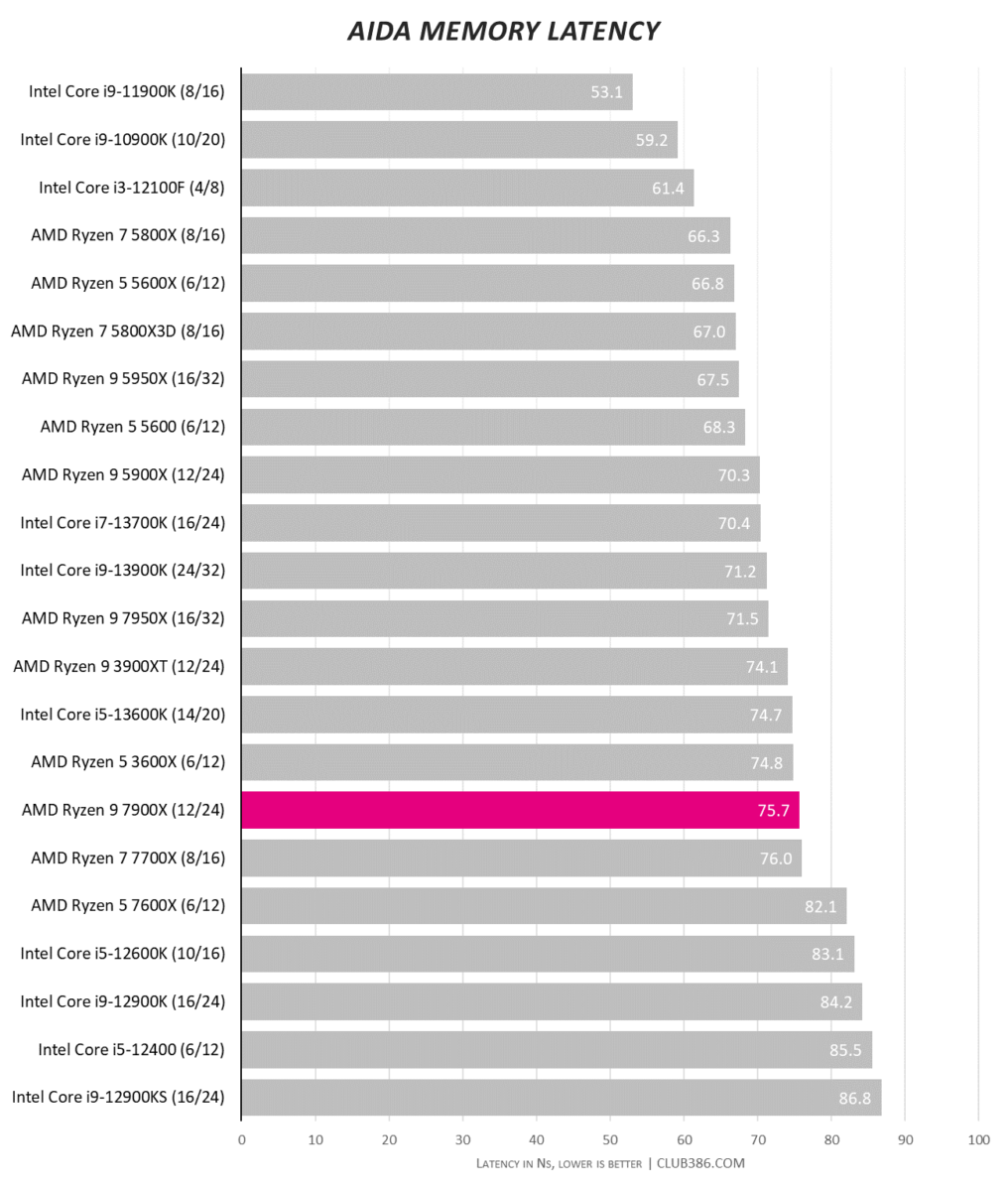
Having dual-channel DDR5-5200 run with tight timings results in mid-pack numbers. Intel gets more out of its DDR5 controller than AMD, according to AIDA, even with the higher DDR5-5600 speed taken into account.
System
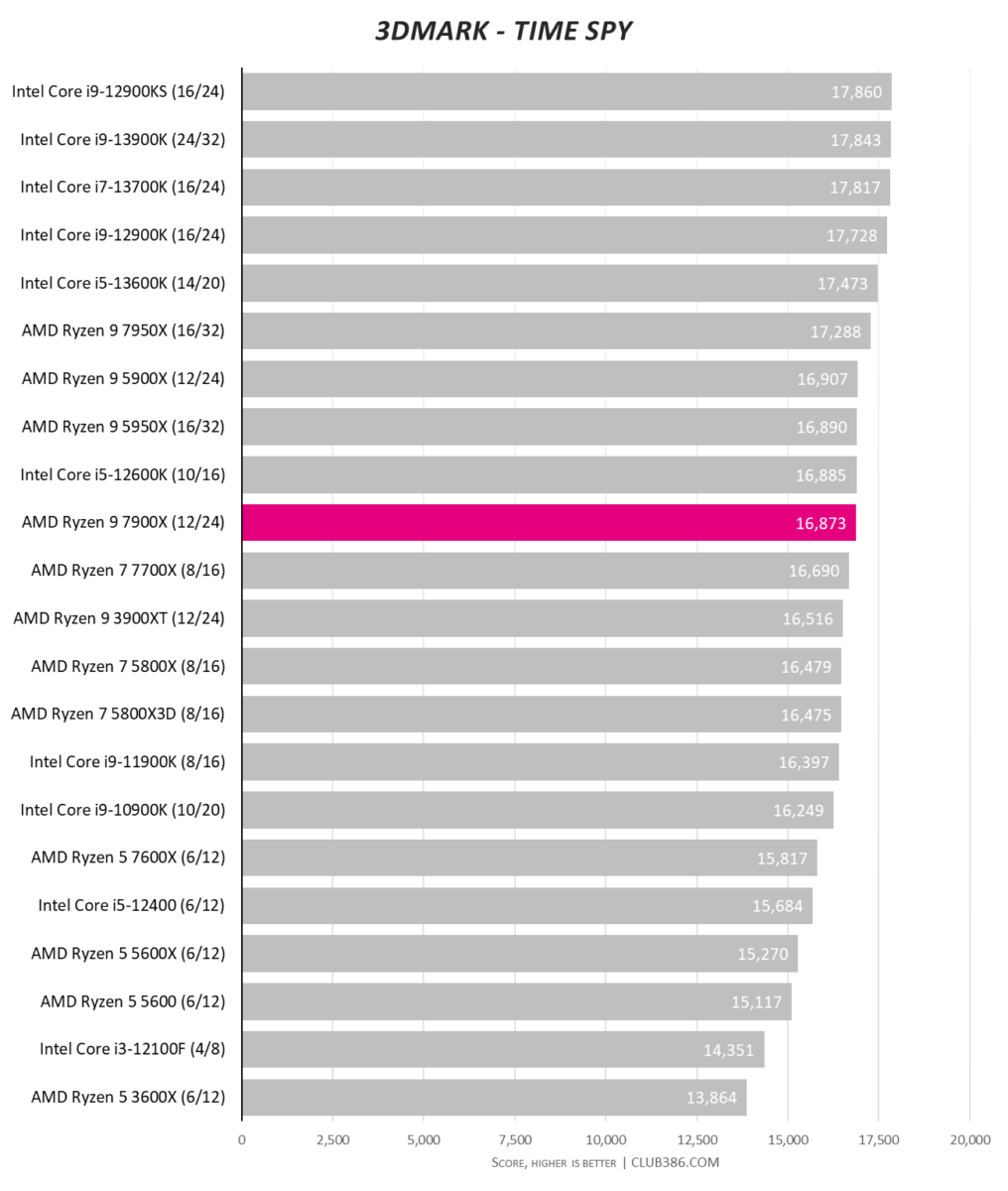
It’s strange to see the review CPU benchmark a tad behind 5900X in 3DMark Fire Strike.
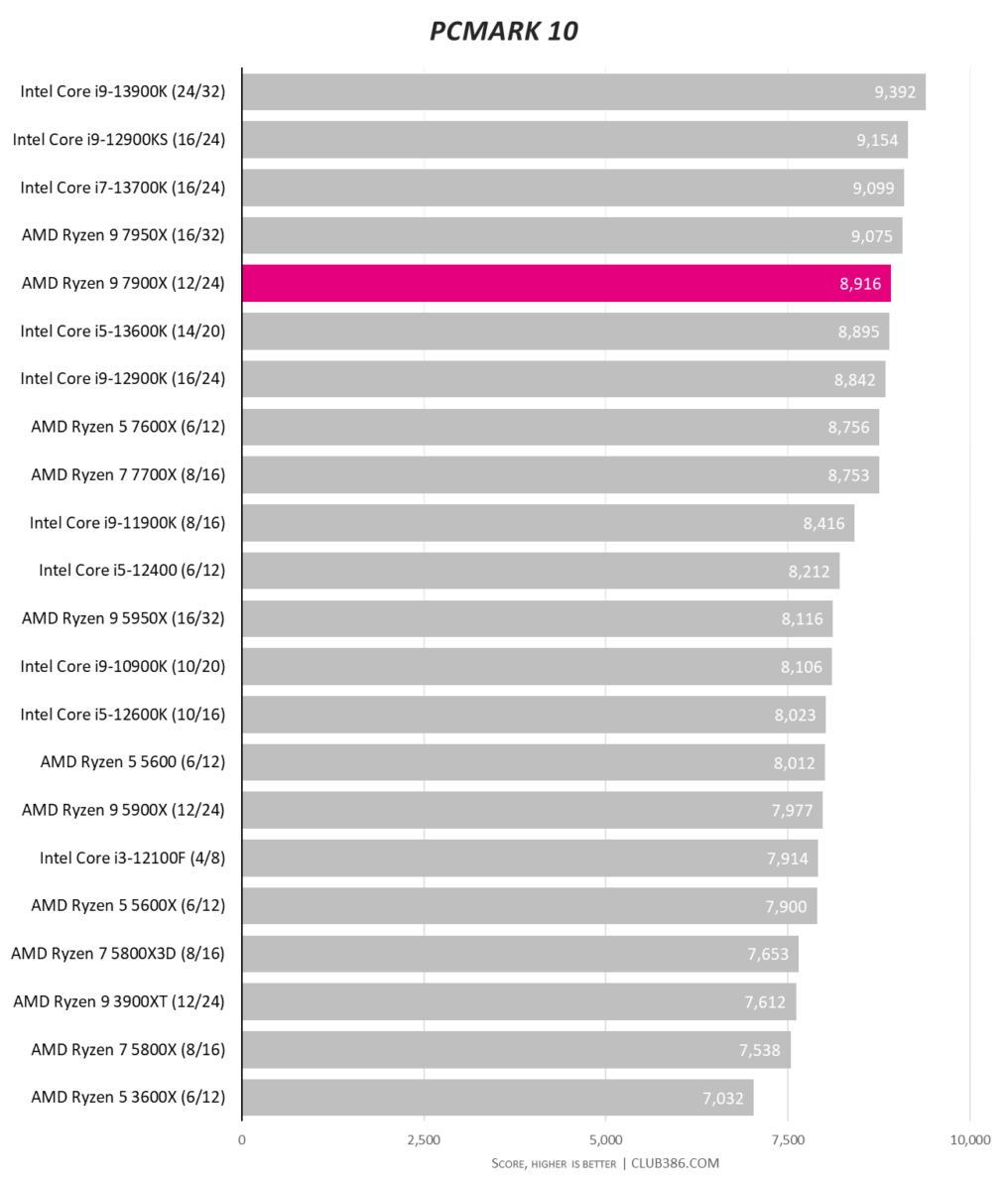
Normal service is resumed in PCMark 10.
Gaming
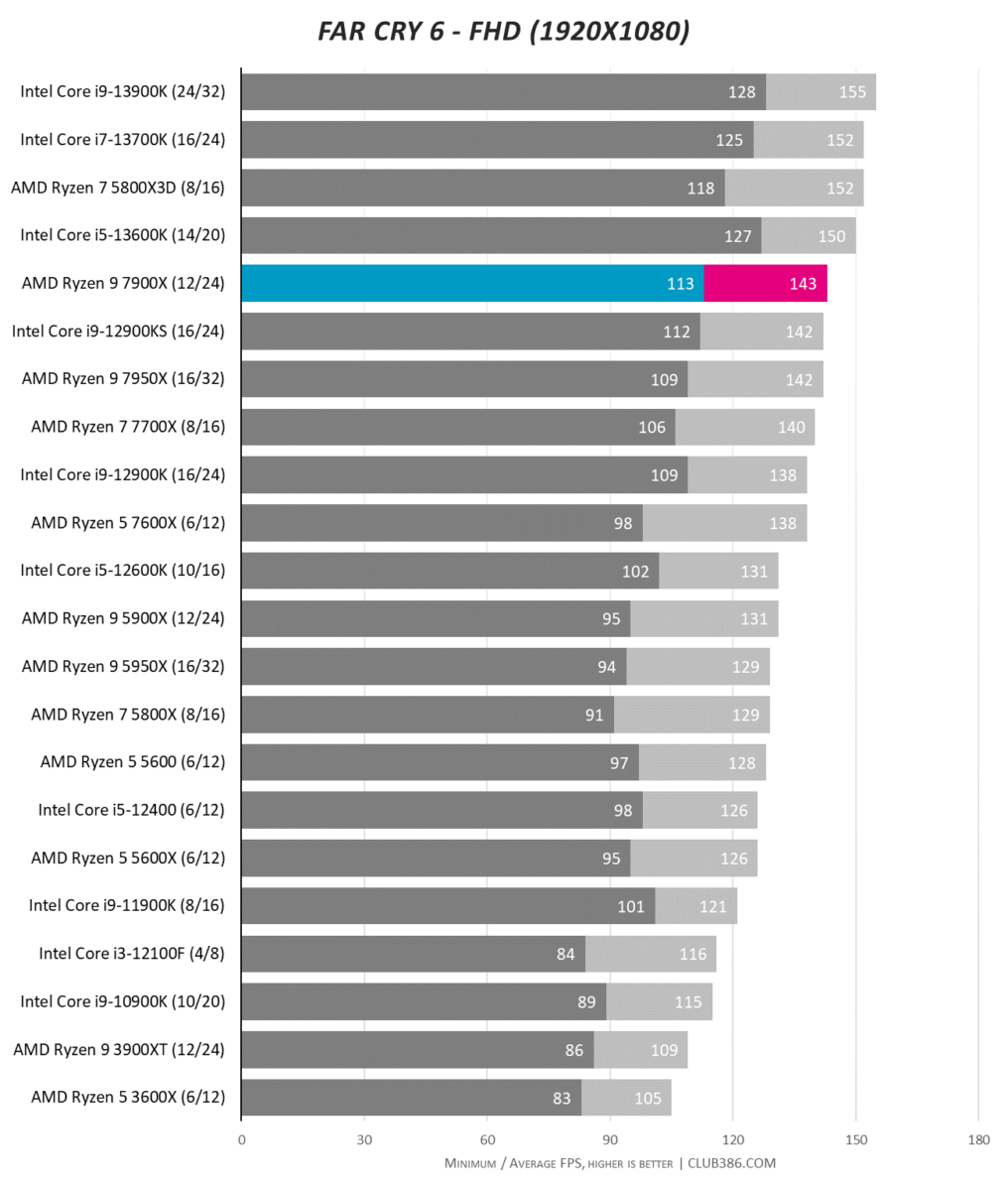
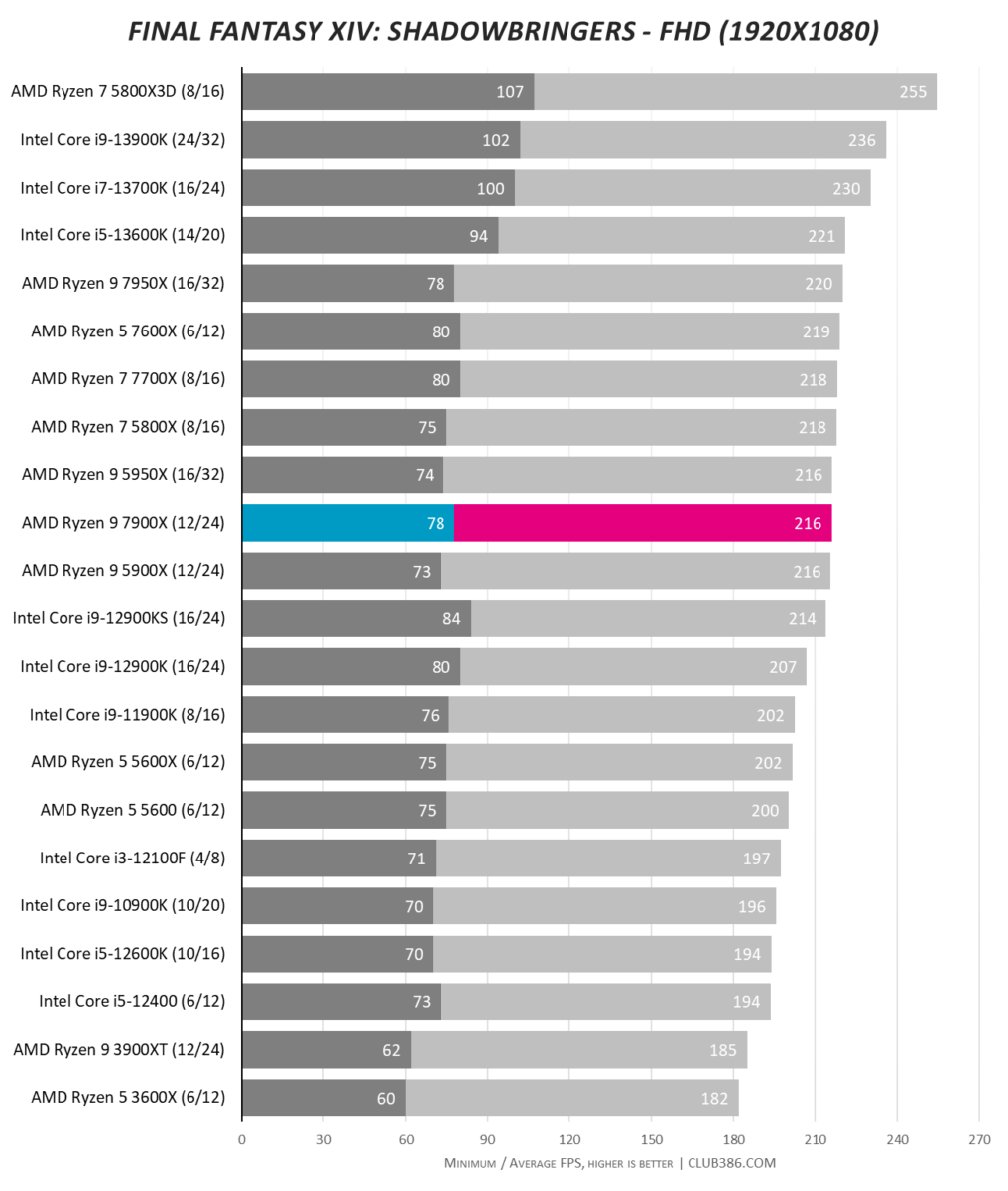
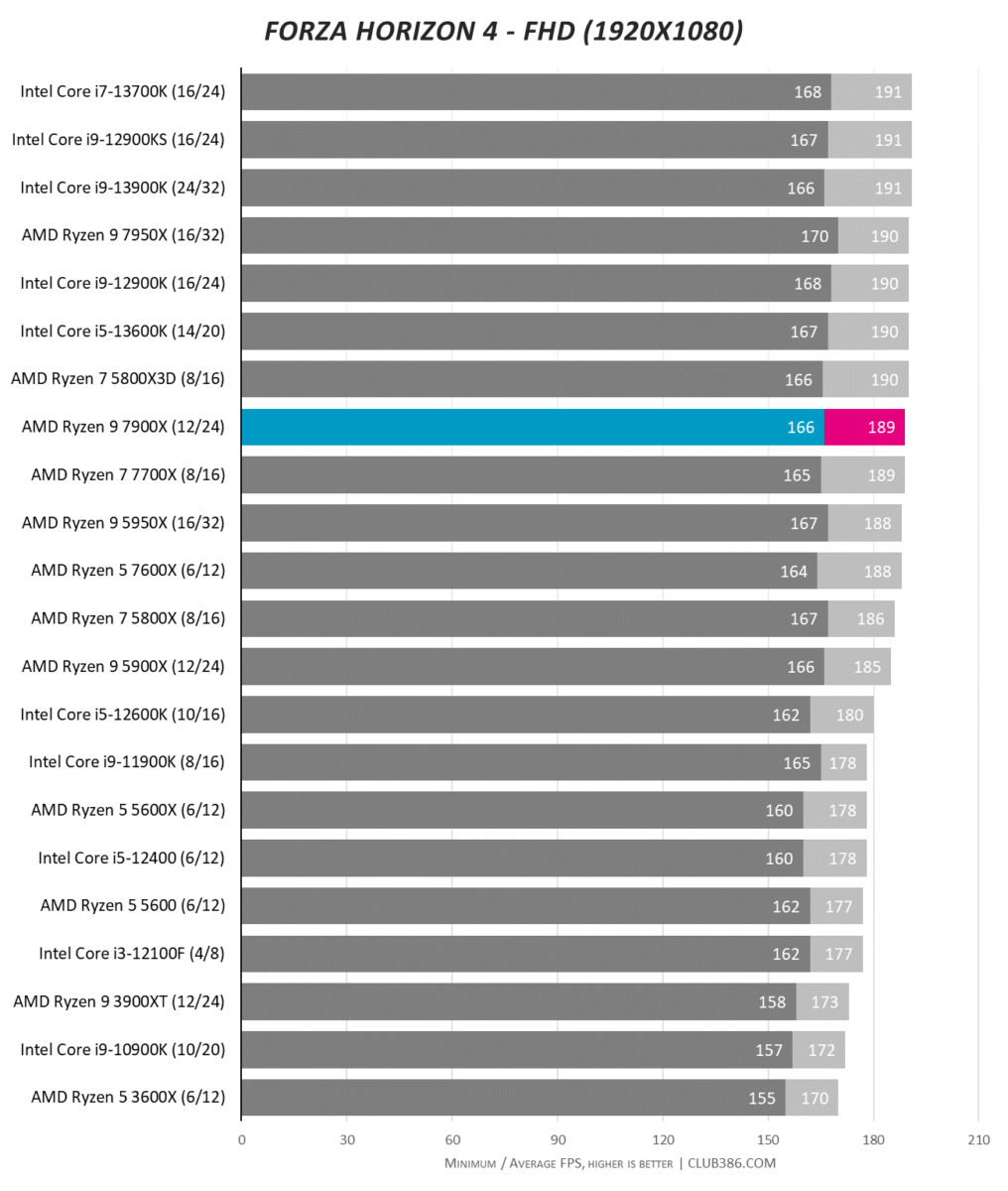
Putting up a robust showing which taps into Ryzen 7000 Series’ many improvements, 7900X’s gaming chops remain decent.
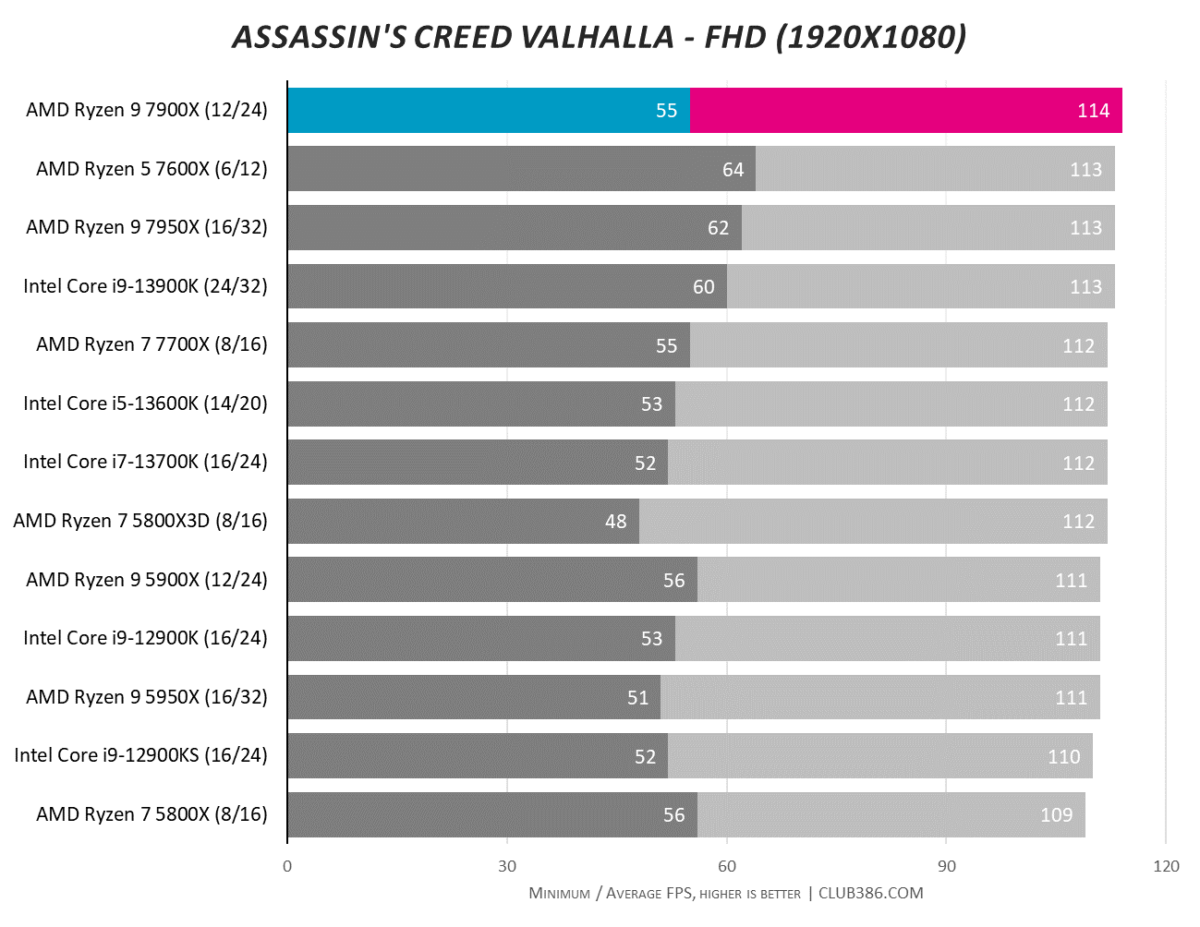
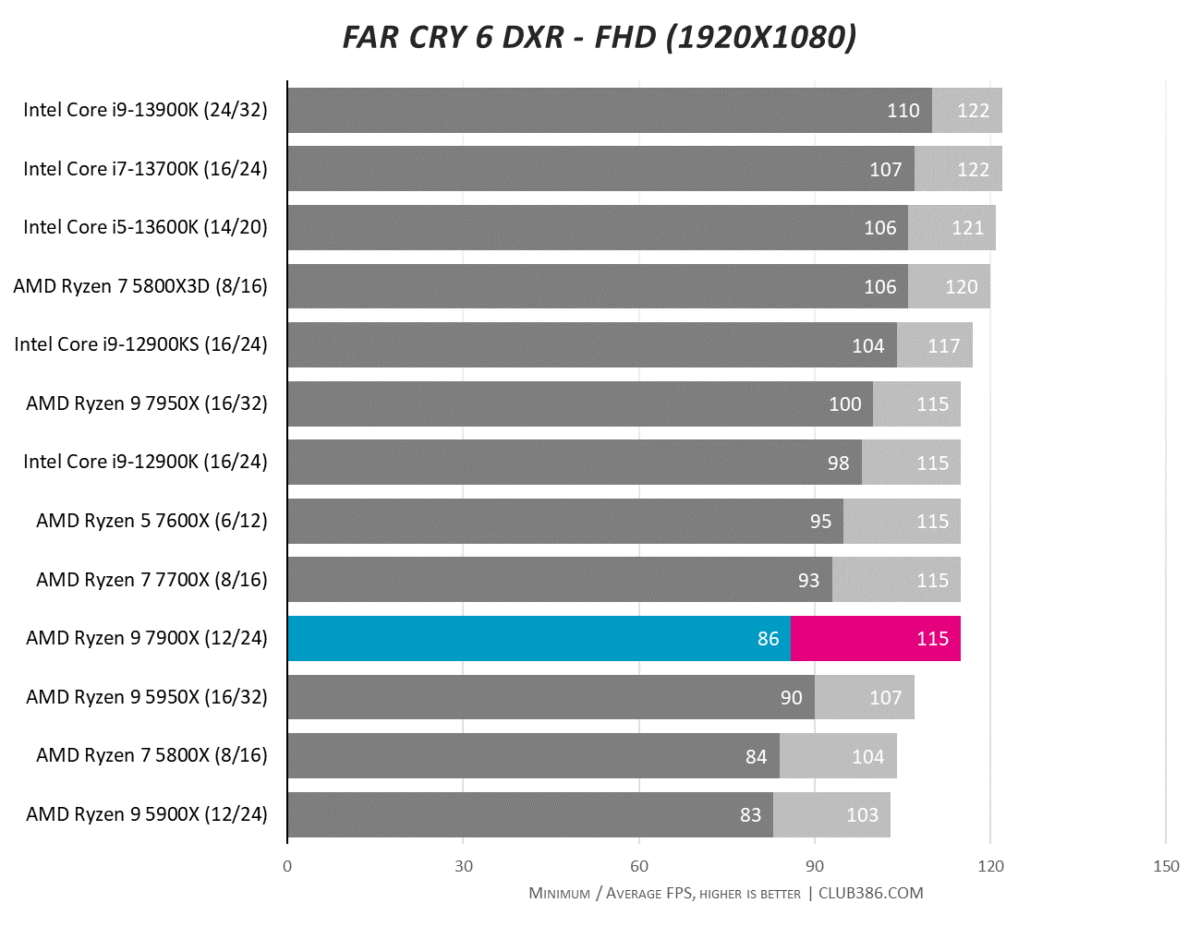
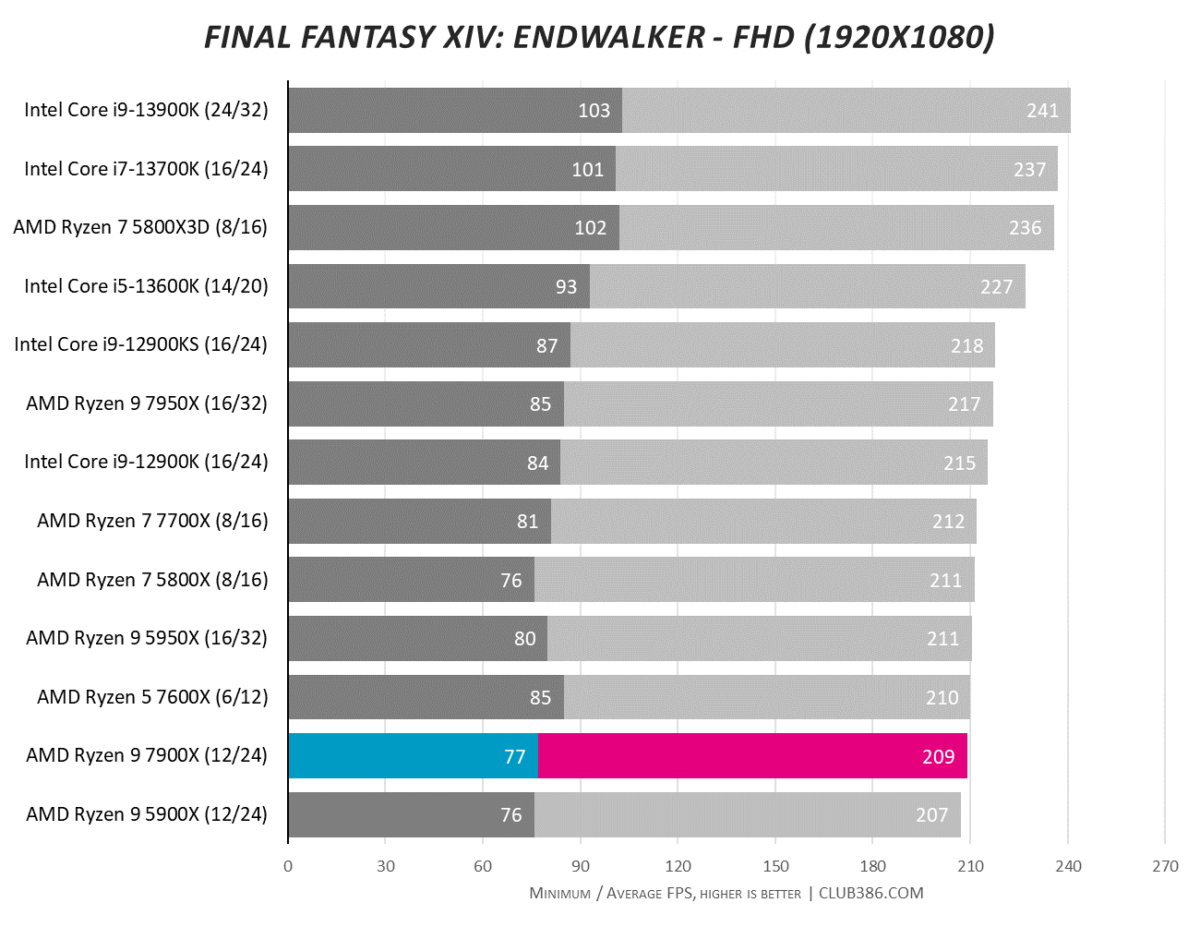
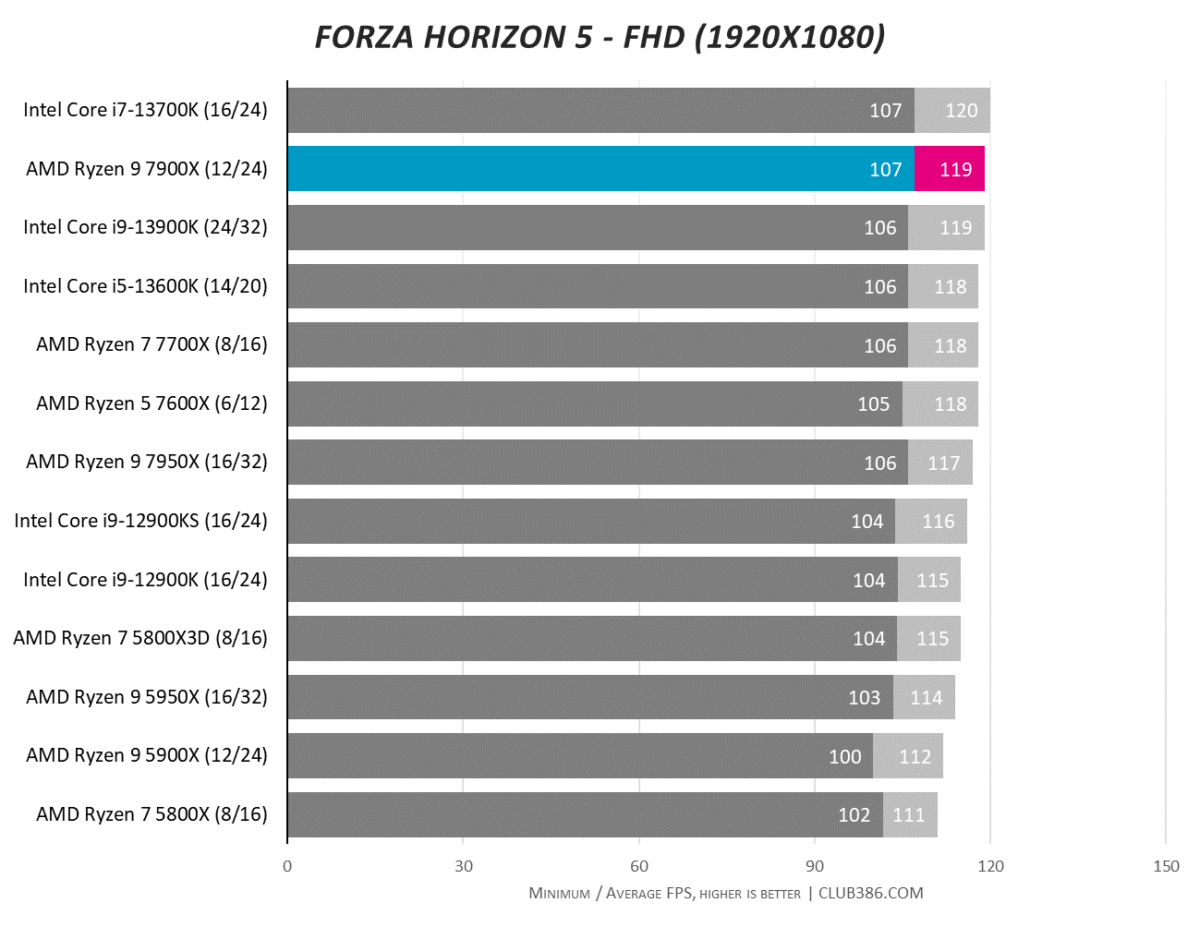
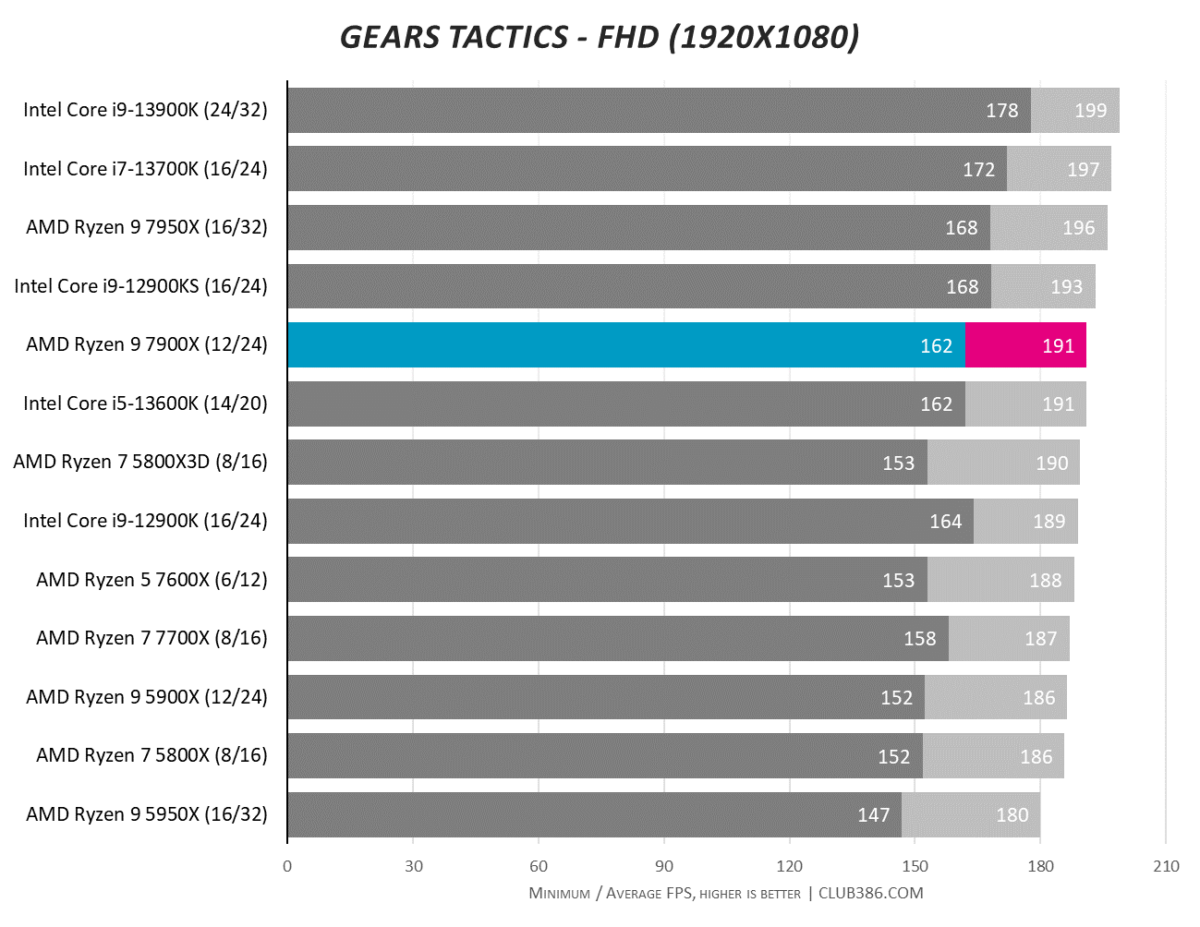
Sometimes it’s easy to fall into the trap of only comparing a processor against other latest offerings, and doing so rarely highlights huge differences between a gaggle of competitors.
Coming from a three-year-old CPU – a typical upgrade cycle for enthusiasts – will leave gamers content with how Ryzen 9 7900X throws out FPS in their favourite titles.
Power, Efficiency and Value
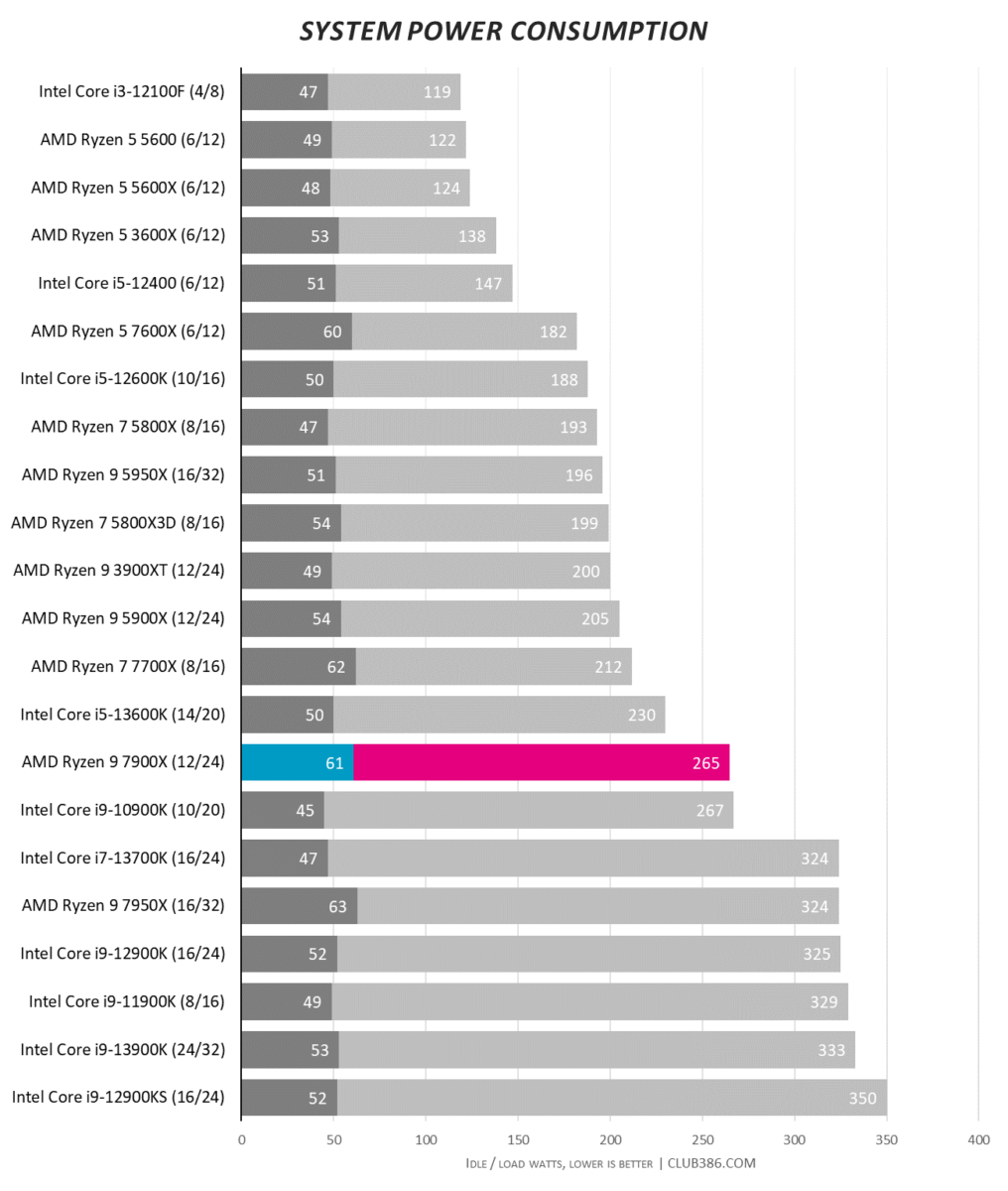
Here’s something interesting. Recall 7900X shares the same 170W TDP as range-topper 7950X. It doesn’t actually use nearly as much when running the multi-core Cinebench R23 benchmark, instead settling on a lower 265W system power figure.
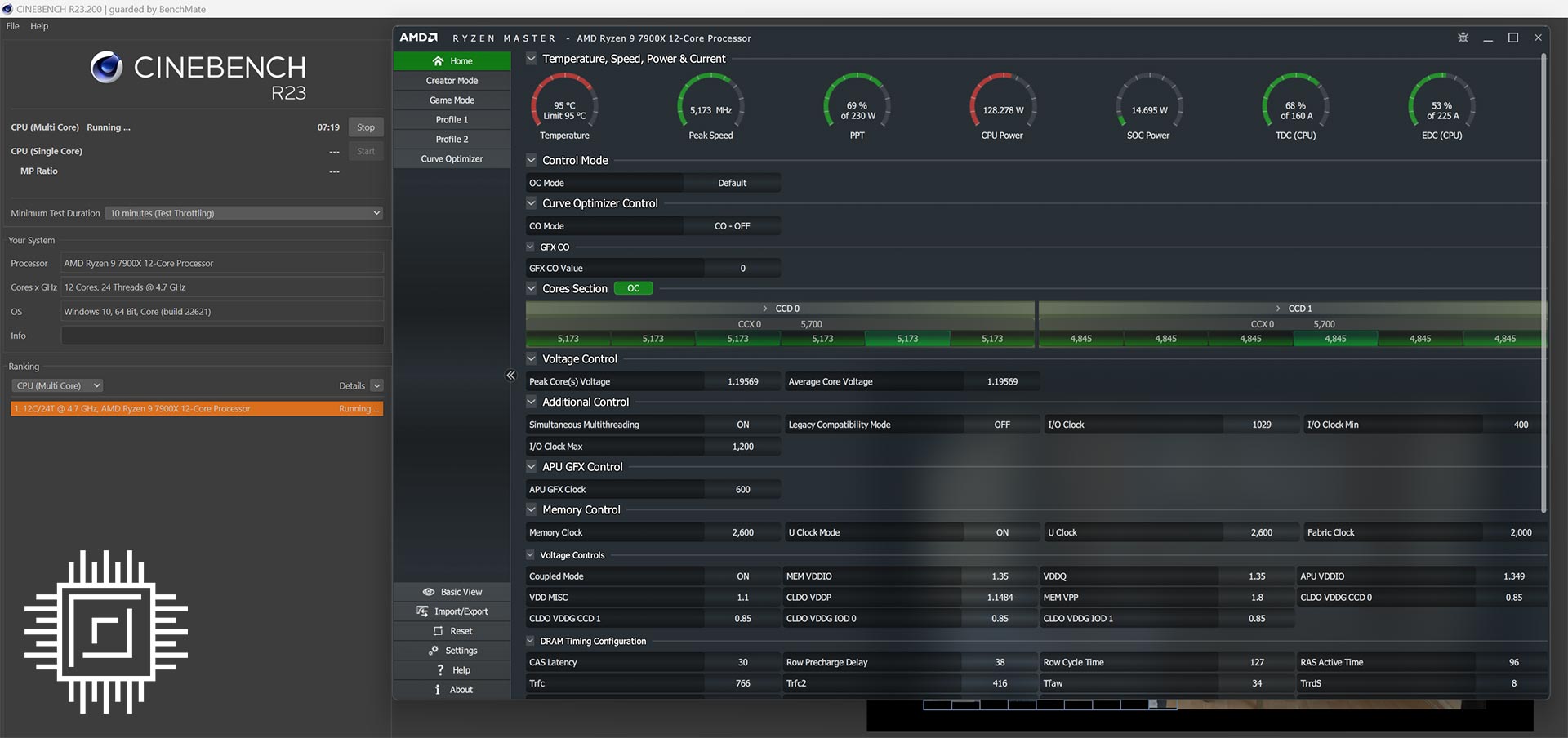
The salient truth is AMD doesn’t need to drive 12 cores and 24 threads anywhere near as hard as the nominal 170W TDP suggests. Perhaps our sample has a better V/F curve than most, but even so, AMD could easily reduce out-the-box power to, say, 140W and still maintain great numbers. Such thought makes the mooted Ryzen 9 7900 a tantalising proposition for small-form-factor systems.
It’s also curious the two CCDs operate at significantly different speeds. Note CCD1 chugs along at 5,173MHz whilst CCD2 runs at only 4,845MHz. The upshot is all-core frequency averages out to around 5,000MHz.
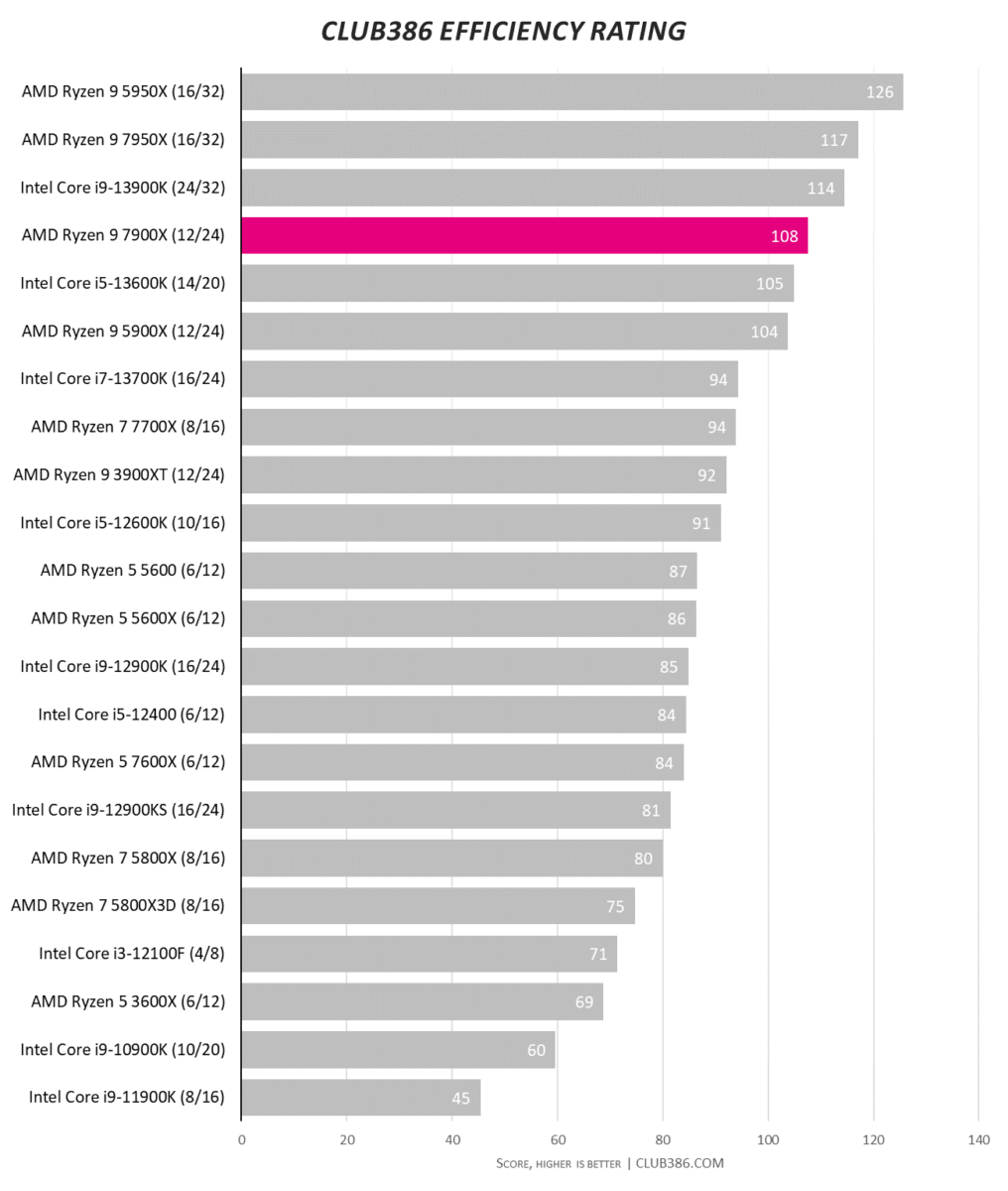
Achieving wholesome multi-core performance and relatively restrained observed power can only mean one thing: a high placing on the efficiency chart that divides observed Cinebench R23 multi-core score by system-wide power consumption.
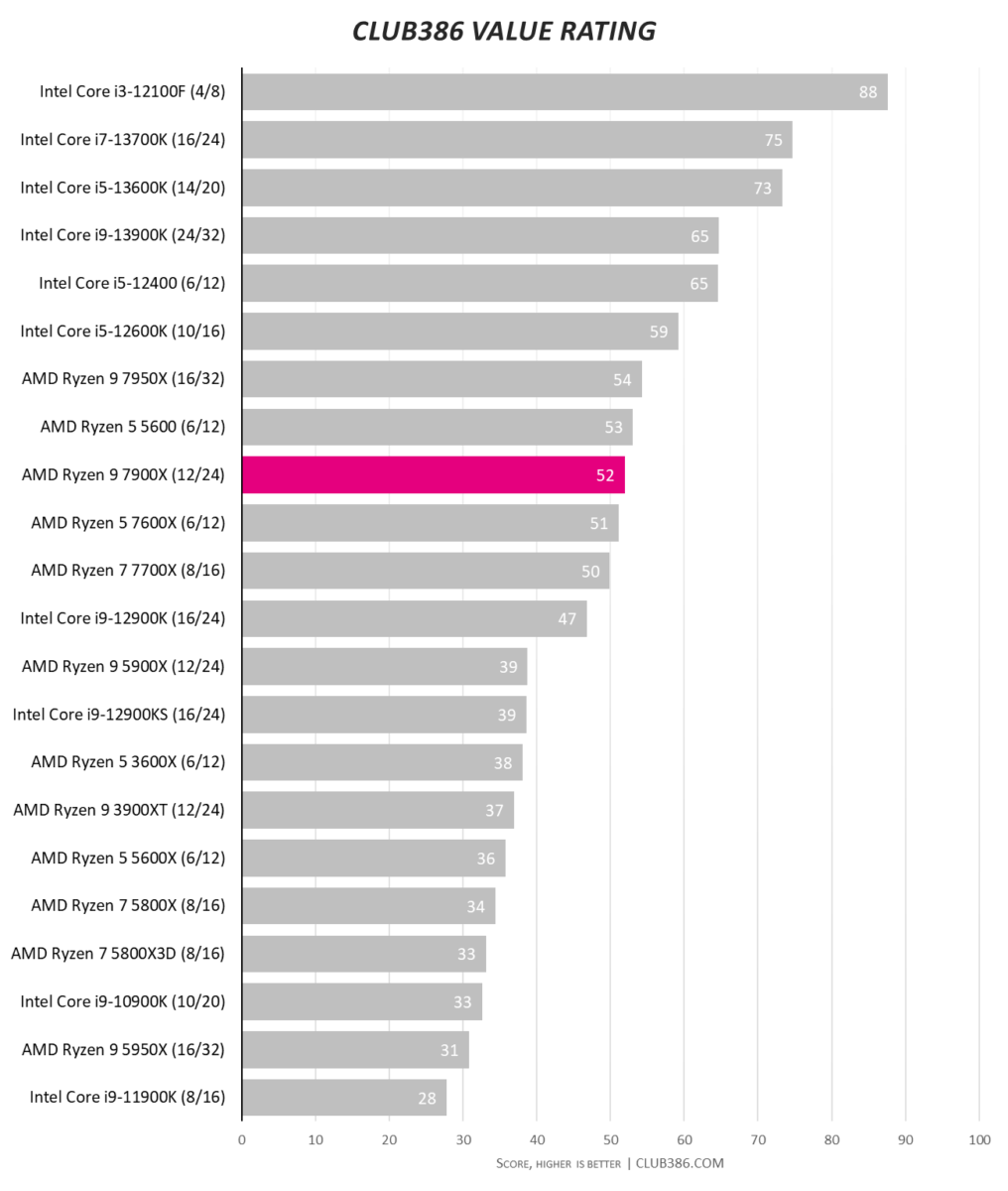
Dividing the same Cinebench R23 multi-core score by retail price gives us the above graph, and it’s here where the official MSRP begins to grate, especially in the context of the 75 scored by Core i7-13700K.
Current retailer discounts bring the Ryzen 9 7900X down to $440, which in turn lifts the Value Rating score all the way up to 65. A meaningful step in the right direction, though AMD would have to drop it right down to $399 in order to achieve a score more in line with that pesky Core i7.
Overclocking
Knowing the processor keeps to an all-core 5GHz straight out of the box with a restrained TDP, we only managed a rock-solid 5.2GHz when overclocking using 1.3V. As AMD prioritises high temperatures – Ryzen 9 7900X also ramps up to 95°C quickly – we observed 108°C even with a dual-fan Noctua NH-D15 cooler on duty.
There was no meaningful increase in gaming performance in the overclocked state; multi-core applications, on the other hand, achieved an average 3.1 per cent gain over stock, which is hardly worth the additional heat and effort.
Conclusion
AMD has made significant strides between desktop CPU generations. Compared to its immediate predecessor, Ryzen 9 7900X offers over one third extra multi-core application performance and presents better gaming credentials thanks to Zen 4 smarts.
Yet no processor lives in a vacuum, and AMD’s progress, whilst impressive in its own right, isn’t as copious as Intel’s. The cheaper 13700K is practically as fast, and memory flexibility offered by the rival adds extra an extra dimension worth thinking about.
Such stern competition is great news for consumers, as price cuts are afoot. Ryzen 9 7900X risked being out of contention at the official MSRP, yet retailer discounts of 20 per cent bring the 12-core powerhouse firmly back into the equation.
Verdict: Much-needed price cuts bring the latest 12-core Ryzen back to the fore.

